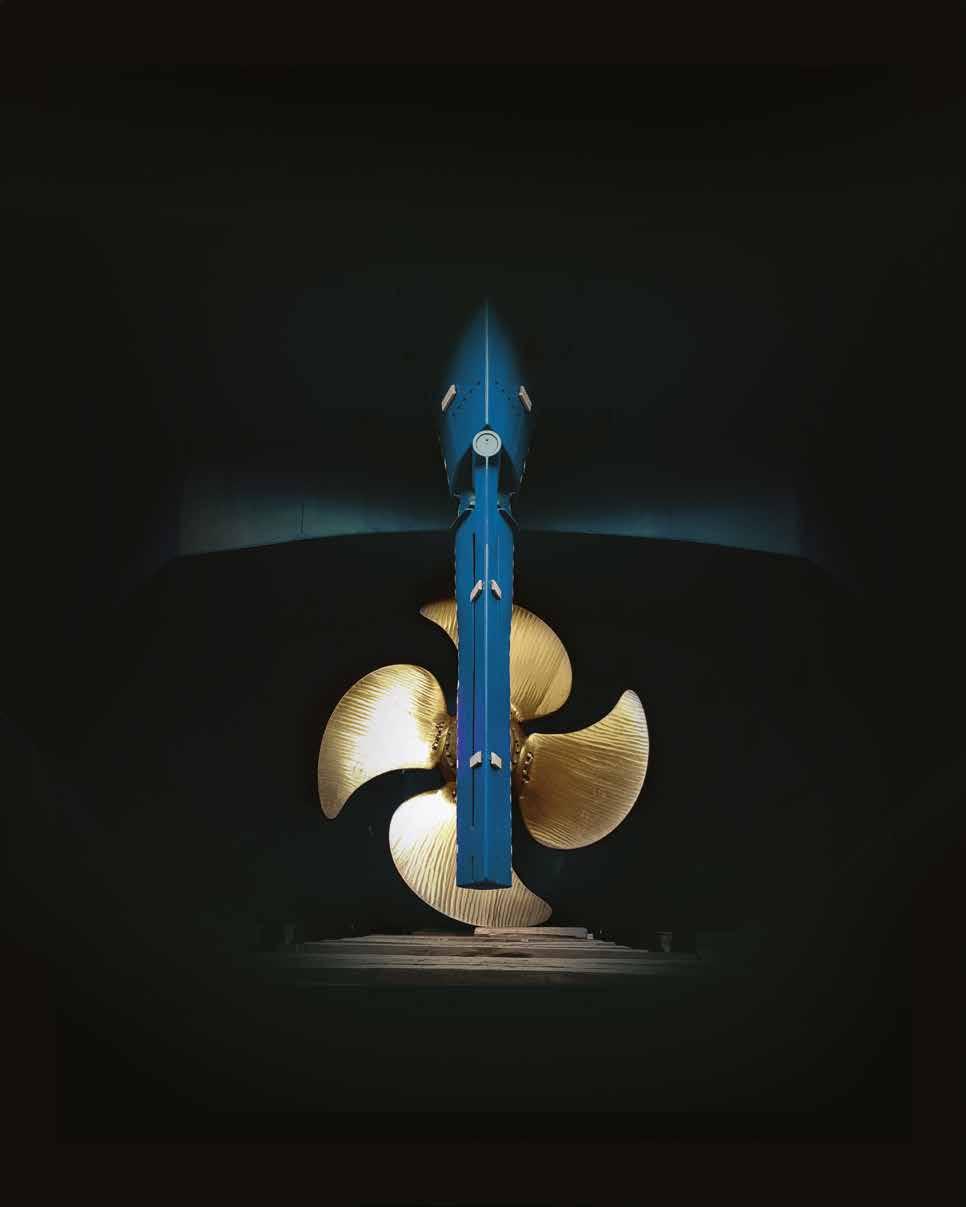The Superyacht Report

















This edition marks the culmination of my time as editor at The Superyacht Group. Over the past five years, I've witnessed first-hand the evolution of an industry in flux. Beneath the surface of record-breaking deliveries lies a landscape shaped by shifting public perception, technological revolutions and changing regulatory forces. These are pivotal times as the superyacht sector defines its future.
Despite all the fascinating events that have unfolded over the past five years, the parting message that I feel is the most prescient is the value of onboard knowledge and the people who hold it. When I sat at sea approaching my 30s, I felt that I had missed my chance to succeed in a ‘normal’ career. In a world where corporate titles dazzle and impenetrable hierarchies loom large, it’s hard to see a way in.
While my friends on land were being promoted to positions with titles like ‘Executive Vice President of Regional Business Development’ or some similar business-speak word salad, they seemed to be both very important and entrenched in impenetrable corporate structures. All the while, I was pushing a chamois and trying to stop the boss’ kids from crashing jet skis into each other.
 BY JACK HOGAN
BY JACK HOGAN
I felt siloed in the golden prison, looking out on a bucolic sunset wondering if my chance to succeed in another life was disappearing with it. If you are reading this wondering the same, let me stress that you are far more valuable than you realise. Equally, if you are an employer shoreside, I implore you to look to this under-utilised reservoir of skill and knowledge.
There are thousands of smart and motivated yacht crew out there who are either looking to get out or have already left a life at sea, and the tragic truth is that the vast majority of their knowledge and insights are lost with them.
The sum total of my self-analysed
abilities, I thought, were to – at most –try my hand at being a junior charter broker or yacht manager. The narrowness of my focus, I am sure, was due to these being the shoreside people I had the most exposure to. Trust me when I say that project management in a corporate setting pales in comparison to a well-executed charter guest BBQ on a tidal beach at sunset, and managing the expectations of people with power and influence is a skill you already have in spades.
This is a fantastic and frustrating industry to work in. Operational experience is foundational to almost all aspects of the shoreside sector. Some of the simplest insights I have passed on have had the biggest impact on my team and the direction of our projects. Piecing together how this experience translates into tangible outcomes for a company will require more creative approaches from employers.
The industry will need to bridge the gap between shoreside machinations and on-board reality if it is to continue to thrive. With rotation rates on the rise, there is even more chance for more engagement shoreside. Officers, engineers and interior crew who are looking to transition shoreside have up to six months a year available. So, use them!
Martin Redmayne and The Superyacht Group gave me the chance to discover what I could do, and I am sincerely grateful to the team for taking a risk on a fresh-off-the-boat officer who didn’t know that an ‘account manager’ didn’t, in fact, work in the finance department. This role gave me the chance to bridge the gap for myself and, hopefully, connect and communicate some diverse and intriguing idiosyncrasies that make this industry so endlessly fascinating. In doing so I know that I brought value to the wider industry and, more importantly, to myself. JH


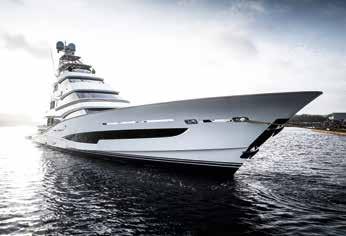

Cracking the code
The REG Large Yacht Code forms the foundation of safe construction in the new-build sector. Here, we take a detailed look at how the 2024 revisions will affect the industry.
80
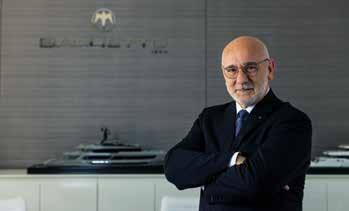
Gross tonnage (gt) is arguably the most misunderstood but commonly used term in the yachting industry. The definition bears repetition. Gross tonnage is a measurement used in the maritime industry to indicate the overall internal volume of a ship. It’s a standardised measure that includes the entire enclosed space within a vessel, including cargo holds, engine rooms, crew quarters and any other enclosed spaces.
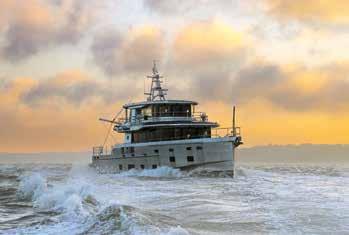
Arksen makes its marque
Baglietto: A benchmark and beyond
Gross tonnage is calculated in accordance with international regulations set by the International Maritime Organ-ization (IMO). The formula for calculating gross tonnage considers the volume of the ship’s enclosed spaces and is used for various purposes, including determining registration fees, port dues
59m and 1,277gt. This will be surpassed in 2024 by a 58-metre RMX Marine project that comes in at a colossal 1,365gt.
It’s important to note that gross tonnage is distinct from a ship’s displacement, which refers to the weight of water displaced by the ship’s hull and is a measure of the ship’s actual physical
While not directly representative of the ship’s mass, it does give a great yardstick as to design trends and the amount of usable space for an owner, and crucially, yachts above a certain gross tonnage threshold may be subject to stricter regulatory requirements for
62 Technical director Jim Mair and build captain Ben Bowley give the rundown on the latest Arksen as the rugged explorer yacht awaits its maiden journey to the Mediterranean.
Evolution of the new-build brokers
The 80-100m scatter plot displays the same trend around the 3,000gt mark, although less pronounced due to the lower number of yachts in this fleet. The grouping of yachts at 2,999gt is obvious, and the variance in gross tonnage is equally large. The outliers of note here are the Corsair Yachts’ modern classic Nero at 90 metres and 1,413gt and the 2019 Silver Yachts’ Bold at 85metres and 1,504gt at the other end of the scale.
Outside these ranges, there are some other noticeable trends in the percentage shifts in gross tonnage since 2000. The
graphic below shows the significant increase in gross tonnage for smaller yachts between 2021-2024 (plus orderbook) in comparison to 2000-2020, most drastically in the 30-35-metre bracket (13.7 per cent) and the 35-40-metre bracket (10.8 per cent), suggesting a trend towards more volume from these smaller yachts. There is a notable decline in gross tonnage for vessels ranging between 50 -55 metres (12.5 per cent), 80-85 (7.9 per cent) and 85-90 metres (14.3 per cent). These declines correspond closely to the scatter plots of gross tonnage vs LOA and the concentration of yachts that are engineered to keep their gross tonnage below the 500gt and 3,000gt regulatory thresholds respectively.
86
Baglietto CEO Diego Michele Deprati on the yard’s latest product lines, its investment in infrastructure and his views on how the market will respond given current world geopolitics.
Percentage shift in vessel GT from 2000-2020 to 2021-2024 plus the order book
To encompass the important 500gt and 3,000gt thresholds, this analysis uses slightly different size brackets, 4560 metres to capture the 500gt mark and 80-100 metres to capture the 3,000gt. There is an inbuilt flexibility in these Gross tonnage calculations, with some designers and shipyards using the full range of the regulations to keep a vessel below a certain regulatory threshold. When the fleet’s gross tonnage is plotted on a scatter plot, it’s fairly obvious where these demarcations occur. This is starkest in the 45-60-metre-plus sector. The logjam of vessels at 499gt is clear to see.
Understandably, there are very few yachts between 500gt and 600gt. A sim-plistic way to view this is that in the design process, if a yacht is going
Today’s brokers have to do much more than just bring cash to the table and then sign off, with clients now considered to be long-term assets rather than merely a one-time source of income.
74
Market insights
We analyse the latest developments, trends and forecasts in deliveries, engine manufacturers and the GT effect, as well as detailing the increasing influence and future growth prospects of SYBAss in the new-build sector.
95
For more than 30 years The Superyacht Report has prided itself on being the superyacht market’s most reliable source of data, information, analysis and expert commentary. Our team of analysts, journalists and external contributors remains unrivalled and we firmly believe that we are the only legitimate source of objective and honest reportage. As the industry continues to grow and evolve, we are forthright in our determination to continue being the market’s most profound business-critical source of information.
INTELLIGENCE
Head of Intelligence
Charlotte Gipson charlotteg@thesuperyachtgroup.com
Research Analyst
Isla Painter isla@thesuperyachtgroup.com
Senior Research Analyst
Amanda Rogers amanda@thesuperyachtgroup.com
Data Analyst
Miles Warden miles@thesuperyachtgroup.com
Production Editor
Felicity Salmon
SuperyachtNews
Spanning every sector of the superyacht sphere, our news portal is the industry’s only source of independent, thoroughly researched journalism. Our team of globally respected editors and analysts engage with key decision-makers in every sector to ensure our readers get the most reliable and accurate business-critical news and market analysis.
Superyachtnews.com
The Superyacht Report
The Superyacht Report is published four times a year, providing decision-makers and influencers with the most relevant, insightful and respected journalism and market analysis available in our industry today.
Superyachtnews.com/reports/thesuperyachtreport
The Superyacht Forum Live
Over the past 30 years, we have delivered the most important conferences and meetings in the superyacht calendar, resulting in a global network of ‘Events Worth Attending’. Our flagship event, The Superyacht Forum Live, has proved to be the largest and most respected meeting of industry decision-makers.
Superyachtnews.com/thesuperyachtforum
The Superyacht Agency
Drawing on the unparalleled depth of knowledge and experience within The Superyacht Group, The Superyacht Agency’s team of brilliant creatives, analysts, event planners, digital experts and marketing consultants combine four cornerstones – Intelligence, Strategy, Creative and Events – to deliver the most effective insights, campaigns and strategies for our clients.
Superyachtnews.com/intel/
Follow The Superyacht Report and Intelligence content
@SuperyachtNews
SuperyachtNews
Join The Superyacht Group Community
By investing in and joining our inclusive community, we can work together to transform and improve our industry. Included in our Essential Membership is a subscription to The Superyacht Report, access to SuperyachtIntel and access to high-impact journalism on SuperyachtNews.
Explore our membership options here: www.superyachtnews.com/shop/p/MH

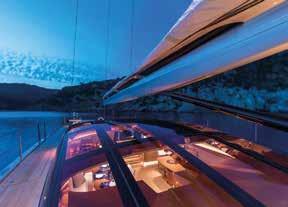

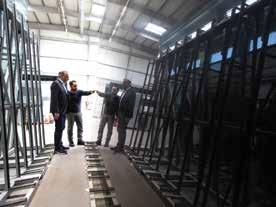
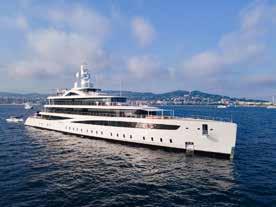



 by Charles Boyle
by Charles Boyle

‘We must be proactive on crew welfare’
Charles Boyle, director of legal services at Nautilus International, says mere compliance with existing regulations
isn’t enough … and the industry must prioritise the well-being of its workforce.
There’s a distinction between the public perception of the glamorous lifestyle of working on superyachts and the actual reality, which rarely matches that perception. The importance of crew welfare is gaining increasing attention across the entire shipping industry, including that relating to yacht crew. While some regulatory frameworks are trying to address these concerns, it’s evident that more proactive measures are needed to truly enhance the quality of life for crewmembers.
Nautilus is doing much to assist its yacht members, with our legal and yacht teams being kept constantly busy on many issues such as dismissals, unpaid wages, discrimination, bullying and harassment as well as regulatory work with the Maritime and Coastguard Agency and Red Ensign Group.
This contributes to the improvement of crew welfare because working and living conditions on board yachts are vitally important. Therefore, the industry must prioritise the improvement of conditions on superyachts and in shipyards, ensuring they are more appropriate for crew. This is an area covered by the Maritime Labour Convention, 2006, and Flag-state implementation laws, measures and guidance.
The MLC contains extensive mandatory rules and guidelines for the provision of decent accommodation and recreational facilities for seafarers consistent with promoting their health and well-being. The MLC is a ‘living instrument’ and is amended by the International Labour Organization every few years.
The 2022 amendments will come into force in December this year, and most relevant for the superyacht industry will be the requirement for mandatory ‘social connectivity’ on board and, where practicable, owners and ports will have to provide internet access. There will also be a requirement for the mandatory provision of appropriately fitting personal protective equipment, for meals to be balanced and drinking water to be provided free of charge (as is already the case with meals).
The MLC also provides for flexibility in how it is implemented, particularly through the concept of ‘substantial equivalence’ as a means of implementation in cases where it’s impossible to adopt the exact letter of the Convention. The UK’s Tripartite Working Group (TWG) oversees the application of such flexibilities on UK and REG vessels.
Particularly important is Part A of the REG Yacht Code, Chapter 21B (applying to yachts more than 200gt), which sets out standards on headroom, ventilation, lighting, food, sleeping accommodation, mess rooms and recreational facilities. Regarding accommodation, the strict letter of the MLC provides that (except on passenger ships) an individual sleeping room shall be provided for each seafarer. However, in the case of ships of less than 3,000gt or special-purpose ships, the MLC allows exemptions from this requirement to be granted by the Flag state after consultation with the shipowners’ and seafarers’ organisations concerned.
The TWG used this flexibility, as set out in
MGN 517, to apply a general substantial equivalence to yachts from 3,000gt to less than 5,000gt, allowing the sharing of a twin cabin by non-officers, with a minimum floor area of at least 11 square metres. The quid pro quo was that each twin cabin must be provided with ensuite sanitary facilities including a WC, a basin and a shower or tub.
The TWG has also been consulted on new-build projects for an equivalence to be applied to yachts more than 5,000gt (which fall outside MGN 517). These applications are carefully scrutinised and approved only if there’s clear evidence the proposals benefit seafarers – for example, crew preferences following a survey of their views. So, in some cases, crew might prefer sharing a cabin in exchange for an en-suite bathroom rather than sharing a bathroom built for six seafarers.
However, mere compliance with regulations isn’t enough. The industry must prioritise the well-being of its workforce by going beyond minimum standards. The upcoming 2022 amendments to the MLC, including mandatory ‘social connectivity’ and improved access to the internet, are steps in the right direction. But more proactive measures are needed to truly enhance the quality of life for crew, both on board and in the yards.
Nautilus will continue to fight for the advancement of the welfare of crew, whether it be by tackling their employment problems or representing their interests with national, regional and global regulators. CB

 by Toby Allies
by Toby Allies

Toby Allies, joint managing director at Pendennis Shipyard, shares his thoughts on why new construction still holds a special place in the hearts of everyone at the yard, and what the future holds for the company in this market sector.
Over the past 36 years, Pendennis has had the privilege to help design, build and craft some of the most iconic yachts that exist in today’s superyacht fleet. During this period, and as a truly bespoke custom builder, we’ve worked with most of the world’s leading naval architects and designers, helping to push both design and engineering boundaries –on projects such as the 42-metre racing icon Rebecca or the 44-metre catamaran Hemisphere
The team has witnessed many ups and downs in the market as well as trends and innovations. One thing that remains constant throughout though is the pure joy and sense of satisfaction that our in-house team of 550 craftspeople experiences on the completion of a new project. Taking an owner’s design and being entrusted to bring their vision to life over a two- to three-year period is an immense responsibility of both time and money for anyone – and something not to be taken lightly!
While for many in the industry, Pendennis might be more recently synonymous with a large-scale complex refit or conversion project, or the restoration of a classic yacht, new construction is still very much a core part of our business. In the early part of this summer, the team will be proud to hand over one of our custom-
build projects to its owner, with the official launch of the 35-metre explorer yacht Fox.
In today’s unstable economic and political climate, few yards would say that the new-build market is anywhere near as strong as it was directly after the pandemic but, as an industry, we feel we’re witnessing a levelling-out to a more stable position. Certainly, for Pendennis, we’re starting to see a consistent number of strong and diverse enquiries coming through our sales funnel, whether this be for an eco-conscious sailing yacht or a more commercial, rugged, off-the-beatentrack motoryacht.
The management team at Pendennis sees a future for our company in the 30-to 60-metre truly custom new-build market, but to survive and thrive in this sector, it’s our belief that we need to concentrate our efforts on two key areas –sustainability and innovation – without changing in any way our absolute commitment to building custom yachts of the very highest quality.
At Pendennis, as with many of our industry counterparts, we’ve implemented and embraced new construction methods that integrate a more sustainable approach to yacht-
building. Examples of this include innovations linked to whole vessel system design and optimisation reviews aimed at minimising emissions and a yacht’s carbon footprint, as well as seeking out alternative modern material selection.
The need for innovation has become paramount for Pendennis. Utilising modern manufacturing methods and technologies is now an integral part of our business ethos. We’re investing in new state-of-the-art facilities and digital manufacturing that will complement and enhance some of the more traditional techniques we employ here at the yard.
Our new digital manufacturing centre will bring together a five-axis joinery mill, a suite of CNC machines and plate profiling and machining equipment into one location that focuses on adding value to our business. Ultimately, this will result in shorter build times.
At Pendennis, we’re confident in the knowledge that comes with our history and the breadth of our in-house skills base. We believe this strong foundation, plus our focus on making custom new construction both sustainable and innovative for clients, will help to keep this sector at the heart of our business for many years to come. TA



Business is flourishing for the industry’s top shipyards. As revealed in the new-build data later in this edition, the delivery numbers in 2023 for 30-metre-plus superyachts reached levels not seen since 2010. This trend is mirrored in the figures for 60-metre-plus custom yachts, with total deliveries reaching their highest point since 2011. However, with only a limited number of yards operating in this space, the lead times for these larger, and often fully custom, superyachts are stretching towards the next decade. The man-hour intensity of these projects extends well beyond the shipyards, and with supply-chain issues and labour shortages still prevalent, bringing these dream projects to fruition on time presents a significant challenge. Transforming a vision from pencil to slipway takes years.
The semi-custom approach is gaining traction, partly as a response to these challenges. Far from being perceived negatively, many designers and shipyards embrace this process as a means of delivering a high-end product while tackling some of the factors that contribute to extended lead times. The reality is that there isn’t always significant variance between the naval architecture of many large yachts, and designing around a defined and well-tested platform streamlines the process.
One of the most prominent forays into the semi-custom model is Oceanco’s Simply Custom initiative, where 15 design studios were invited to submit designs based on a set platform. With most of these submissions now showcased in the press, Jim Dixon, director of yachts & aviation at Winch Design, gave us his insight about the company’s striking concept Project Reverie.
Oceanco’s Simply Custom initiative collaborates with a notable array of renowned design studios, demonstrating a commitment to diversity in design and innovation. Among those mentioned are Bozca Limitless Design, Espen Øino International, H2 Yacht Design, Harrison Eidsgaard, Hot Lab, Lobanov Design, Nuvolari Lenard, Pascoli International, Sinot Yacht Architecture & Design, Sorgiovanni Designs, Taylor Design, Team For Design – Enrico Gobbi, The A Group, Touch Studio, Vallicelli Design and, of course, Winch Design.
According to Dixon, Winch Design’s strategy for innovation within the Simply Custom framework, and to stand out from this impressive gallery of design talent, focuses on deep market analysis and client needs, recognising the evolving ways clients utilise yacht spaces.
“The essence here is our commitment to a design philosophy that shuns a ‘house style’, opting
instead for a reflection of the client’s personality and desires,” says Dixon. “Each project, such as Project Reverie, is treated as a unique undertaking, showcasing Winch Design’s dedication to creativity and problem-solving in the face of unprecedented design challenges.”
Winch is well placed to take up this challenge, having worked extensively within a similar framework with another top Dutch shipyard, Damen Yachting. Dixon feels that Winch’s approach is illustrated in its diverse design contributions to the Amels semi-custom fleet, emphasising customisation and individuality.
Dixon explains, “If you look at the number of different interiors we have designed across the Amels semi-custom fleet, for example, you will see that each interior is completely unique to the individual client and covers a range of different interior styles. In the Amels 242 Limited Edition Series, we designed the interior for Synthesis, Avanti and M&Em, and we are currently working on hull number eight. We have also worked across a number of the Amels 60 Limited Edition Series.
“The way clients use space on a yacht is evolving, and our latest concept with Oceanco explores a unique layout that blurs exterior/interior spaces,
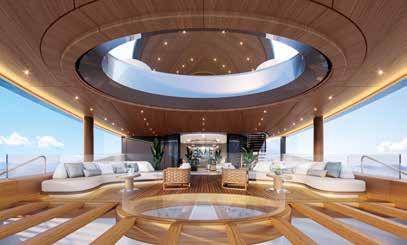
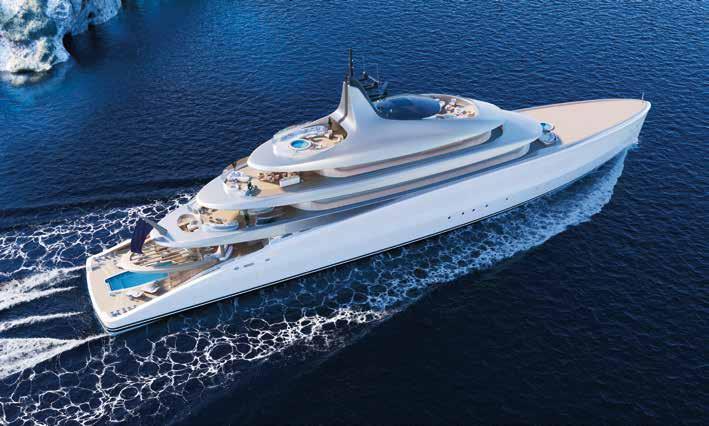
“The design introduces a novel three-deck beach and wellness concept, enhancing the connection to the sea and promoting sustainable living by integrating spaces that reduce reliance on air conditioning.”
offering more flexibility to suit the lifestyle of a dynamic owner.”
According to Oceanco, its Simply Custom technical foundation serves as a blank canvas, offering designers the flexibility to create an Oceanco yacht with distinctive character while adhering to a highly optimised and efficient hull design developed in collaboration with Lateral Naval Architects.
This foundation includes a future-proof allelectric propulsion and energy system, alongside a layout that accommodates the foundational features of a superyacht. The typical configuration provided by Oceanco’s Simply Custom platform, which adheres to the Red Ensign Group Large Yacht Code Part A Regulatory Compliance, includes an owner’s stateroom and six guest suites.
For Project Reverie, this is complemented by luxury amenities such as a forward helideck, a main deck aft pool, a beach club and a dedicated storage room for electric toys that could include items such as e-bikes, underwater scooters or electric surfboards.
With the other design submissions now publicly available, the natural next question is how Dixon sees it in comparison to the rest of the field.
“Project Reverie distinguishes itself through its inspiration from the beauty of daydreams and nature, achieving a harmonious blend of sleek lines and simplicity that exudes elegance,” says Dixon. “The design blurs the line between indoor and outdoor living, aligning with the dynamic lifestyle of today’s yacht owners. It introduces a novel threedeck beach and wellness concept, enhancing the connection to the sea and promoting sustainable living by integrating spaces that reduce reliance on air conditioning.
“The semi-enclosed main deck ‘pool lounge’
offers a unique space designed to bring daily family pleasure, breathing new life into a typically underutilised area. This design also fosters a more sustainable approach by allowing interior and exterior spaces to coexist, reducing the demand on air-conditioning systems.”
The shift towards semi-custom yacht builds, as exemplified by the Simply Custom range, offers a strategic response to the prolonged timelines inherent in fully custom projects. This approach not only addresses time constraints, but also empowers clients to commence their yacht journey from a pre-established platform, ripe for personalisation. By streamlining the initial stages with a verified foundation, this trend has the potential to redefine the premium-yacht-market landscape, emphasising efficiency while retaining the hallmark elements of luxury and customisation.
The conventional route of embarking on a fully custom-yacht build is undeniably laborious and time-intensive. In recognition of this, shipyards are increasingly introducing larger semi-custom models into the market. The Oceanco Simply Custom range serves as an illustration of this evolving approach, theoretically offering clients the best of both worlds – a framework for swift customisation without compromising on the bespoke elements that define luxury yachting.
“The unveiling of Project Reverie and its subsequent promotion have generated positive feedback from both clients and the industry, especially following the release of new exterior and interior visuals,” concludes Dixon. “The interest spurred by these discussions at events like the Dubai Boat Show underscores the market’s receptiveness to Oceanco’s innovative Simply Custom concept and Winch Design’s visionary execution.” JH
With increasing focus on the operational impacts of today’s superyacht fleet, are new-build shipyards doing enough to improve their in-house sustainability processes, with the clock ticking down to the looming deadline of 2030?
Shipyards sustainability report
mprovements in the design and operational impact of superyachts often attract attention and make headlines. However, everyone within the industry plays a role in enhancing sustainability, and shipyards are just one of these groups.
While designers’ choices affect the impact of the usage phase of a superyacht’s life cycle, shipyards are responsible for the ‘cradle-to-gate’ element of a superyacht. The impact of these steps depends heavily on the facilities, materials used and processes the shipyard employs.
Reducing these impacts will be a particular priority for many shipyards in the EU as the Corporate Sustainability Reporting Directive (CSRD) comes into effect over the coming years. This requires them to assess their impacts and implement plans and strategies to reduce them. Therefore, many new-build shipyards will need to catch up with other manufacturing industries such as luxury cars, aviation and even refit yards like Amico & Co and MB92 – all of which are regularly publishing sustainability reports.
As environmental, social and governance (ESG) requirements increase, shipyards will benefit from implementing strategies to reduce their impacts and demonstrate progress. Legislative and other mandates will drive actions covering various aspects of sustainability. As well as environmental impact reduction, it’s crucial to address all facets of sustainability. This necessitates incorporating sustainability into business operations through diverse approaches to achieve set targets.
New-build shipyards represent a sector of the industry still in the nascent stages of its sustainability journey. This is evident from the lack of relevant reports and the cautious language used by yards in their responses, such as ‘investigating’ and ‘looking into’ when addressing future activities and choices.
While such language demonstrates intent from shipyards, there appears to be a disconnect between this intent and tangible actions with measurable impact reduction achievements or defined strategies. Vague, uncertain elements within sustainability efforts may not meet the increasingly stringent ESG-related requirements that will apply to these shipyards in the future.
We contacted multiple superyacht shipyards to find out what they are doing to reduce their impact. While there’s no single solution, learning from the steps taken by a diverse range of yards, manufacturing in equally diverse regions, paints an intriguing picture of how far the industry has come … and how far it still has to go.
Among the most referenced impact reductions from the yards we spoke to was that of energy usage within the facilities. As we all have undoubtedly seen over the past few years, many shipyards are installing solar-panel arrays. However, even a cursory look at the maths shows this can account only for nominal savings compared to the overall energy needs across an average newbuild process.
A far more significant lever is purchasing energy from renewable sources. Baltic Yachts sets an example with some
of the best energy sourcing available. Its location in Finland allows for all power used in its production facilities to be sourced locally from wind farms and hydropower facilities. This renewable energy will be the lowest impact type of energy available – commendable, but this is due to the progressive energy policies in Finland.
Not all production facilities will be able to attain this level of low-impact energy supply. One example of this is Southern Wind, in South Africa. As seen in the graphic below, South Africa’s energy consumption is sourced almost entirely from fossil fuels, whereas Finland’s is less than half from fossil fuels. This energy-supply issue contributed to a life-cycle assessment (LCA) carried out by Southern Wind into its new-build and existing fleet, which found that electricity was a significant contributor to the impact of its yachts.
The goal of achieving a majority or total renewable energy supply is a common element found in the reports of other similar industries that have progressed further in sustainability than the superyacht industry. For instance, Aston Martin, Learjet and Textron have successfully operated one or more of their production facilities on 100 per cent renewable energies. These sustainability reports from comparable industries offer valuable insights into the potential trajectory of the superyacht industry.
Another prevalent theme among shipyards, as well as other industries, is waste reduction. This involves two primary factors: firstly, reducing waste generated in the first place, which decreases the demand for raw materials, and, secondly, maximising waste that will be recycled or repurposed, thereby increasing the supply of recycled
Lorem ipsum dolor sit amet, consectetur adipisicing elit, sed do eiusmod tempor incididunt ut labore et dolore magna aliqua. Ut enim ad
minim veniam, quis nostrud exercitation
eiusmod tempor incididunt ut labore et dolore magna aliqua. Ut enim ad
minim veniam, quis nostrud exercitation
ullamco laboris nisi ut aliquip ex ea commodo consequat. Duis aute irure
minim veniam, quis nostrud exercitation
ullamco laboris nisi ut aliquip ex ea commodo consequat. Duis aute irure
dolor in reprehenderit in voluptate velit
esse cillum dolore eu fugiat nulla pariatur.
Teak, in particular, poses sustainability challenges due to high demand outpacing its replenishment rate. While technically renewable, the rate of consumption exceeds the pace of new growth.
materials and reducing reliance on landfill or incineration disposal methods.
Shipyards have prioritised waste reduction by enhancing manufacturing efficiency, yielding significant benefits for business operations. This approach not only reduces material costs, but also minimises expenses related to waste storage, processing and disposal.
For example, Sylke auf dem Graben, marketing team leader for Lürssen, confirms Lürssen employs digitalisation in its piping workshop to streamline processes and cut waste, while Southern Wind optimises material use through IT and data systems. Feadship focuses on reducing packaging waste from the supply chain and using more easily recycled options, and Baltic Yachts has quantified its efforts, achieving more than a 10 per cent reduction in waste per labour hour.
Among the shipyards surveyed, Baltic Yachts stood out for achieving zero unsorted waste by utilising the Finland-specific KiMuRa-route scheme to recycle industrial composite waste. Feadship is also using additional recycling programmes for its range of waste materials, which includes a national
10%
REDUCTION IN WASTE PER LABOUR HOUR AT BALTIC YACHTS
OF WASTE REDUCTION IN 2022 AT LEARJET
95%
OF ASTON MARTIN’S SUPPLIERS HAVE ATTAINED ISO 14001 CERTIFICATION
2030
DATE FOR FEADSHIP’S GREENHOUSE - GAS - EMISSIONSREDUCTION TARGETS
scheme to repurpose wood waste, and facilities that utilise non-recyclable waste to generate heat/electricity.
As industry reports increasingly emphasise waste-reduction goals, such as those found in Damen Yachting’s and Fincantieri’s sustainability reports, we can anticipate more evaluation of such efforts in the superyacht sector. For instance, Learjet’s 2022 sustainability report showcased a notable achievement of over 800 metric tons of waste reduction across more than 90 projects, setting a benchmark for the industry.
Improvements in waste-disposal routes must be accompanied by shifts in the materials used in superyacht construction. Teak, in particular, poses sustainability challenges due to high demand outpacing its replenishment rate. While technically renewable, the rate of consumption exceeds the pace of new growth. Despite this, teak’s unique qualities for maritime use make it difficult to replace with more sustainable alternatives.
Consequently, considerable focus, research and development have been directed towards finding suitable substitutes. Lürssen collaborated with the
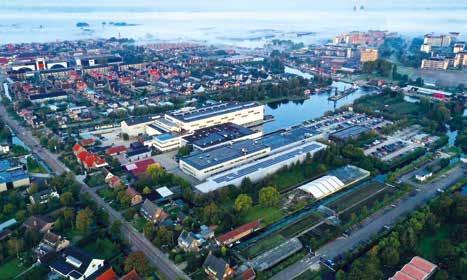
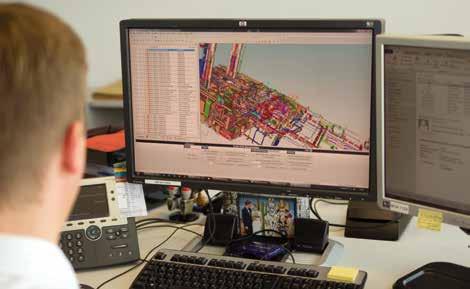
University of Göttingen to develop the patented Tesumo material, offering an alternative to teak. Similarly, Southern Wind employs maple decking as a sustainable option.
Recycling waste is one part of circularity, the other is utilising recycled materials. Examples of this from shipyards are Feadship using recycled metals or Southern Wind using recycled PET core materials in construction. Using recycled materials is better because it has reduced impact from both the disposal of materials and impact savings from cutting the amount of material production required.
Another approach is to obtain locally sourced materials to reduce associated transport emissions – a priority for Baltic Yachts. However, Pamela Honga, head of quality and sustainability at the company, explains, “Sometimes customer choices and the scarcity of specific items need to come from abroad.” In such cases, efforts are made to ship these items in bulk and organise common transport routes to minimise additional transport emissions.
This reflects a broader effort within the industry to advance sustainability. Umberta Bassino, marketing and communication manager at Southern Wind, emphasises the need for support from the supply chain, highlighting the importance of engaging with suppliers to drive improvements collaboratively.
Both Feadship and Southern Wind have expressed their commitment to prioritising preferred supplies, equipment and materials. This underscores the growing demand for environmentally friendly construction materials, with increasing pressure for external certification or scientific validation of their sustainability credentials.
An external example of this approach is Aston Martin’s requirement for suppliers to comply with ISO 14001, an environmental management system standard. Presently, 95 per cent of its suppliers have attained this certification. This underscores the potential benefits for suppliers to invest in the development of suitable alternatives for shipyards, exemplified by Lürssen’s co-creation of a teak alternative.
In addition to the activities mentioned above, there are also investments to be made directly in the shipyard facilities themselves into equipment that
Below: Photovoltaic installation at Feadship’s Aalsmeer facilities. Bottom: Lürssen’s digitalisation of piping to prevent waste.The key question revolves around whether clients are willing to absorb additional costs in the pursuit of life cycle and shipyard sustainability.
improves efficiency and other methods to reduce consumption or emissions associated with the running of the yard.
One example of this is Feadship’s goal of becoming carbon-neutral by 2030. Specifically, Feadship aims for 95 per cent reductions for Scope 1 and 2 greenhouse gas emissions and around 45 to 65 per cent for Scope 3 by 2030. This is planned to be achieved through extensive investments such as new machinery, installing smart systems, changing lighting systems, and optimising heating, cooling and ventilation systems. These measures will reduce consumption and emissions but the company is also looking to break away from fossil fuels which, while unspecific, can be assumed to be similar to other changes such as that made by refit yard Cantiere Rossini to replace diesel with HVO for on-site equipment.
Lürssen, too, is investing in energyconsumption changes at its facilities, utilising LED lights among wider plans to implement more energy-efficient options for facades and windows, alongside emission control and filter technology.
Baltic Yachts has implemented a dif-
 Baltic Yachts’ Pink Gin Verde comes with a durable alternative cork deck material from Marinedeck exterior.
Baltic Yachts’ Pink Gin Verde comes with a durable alternative cork deck material from Marinedeck exterior.
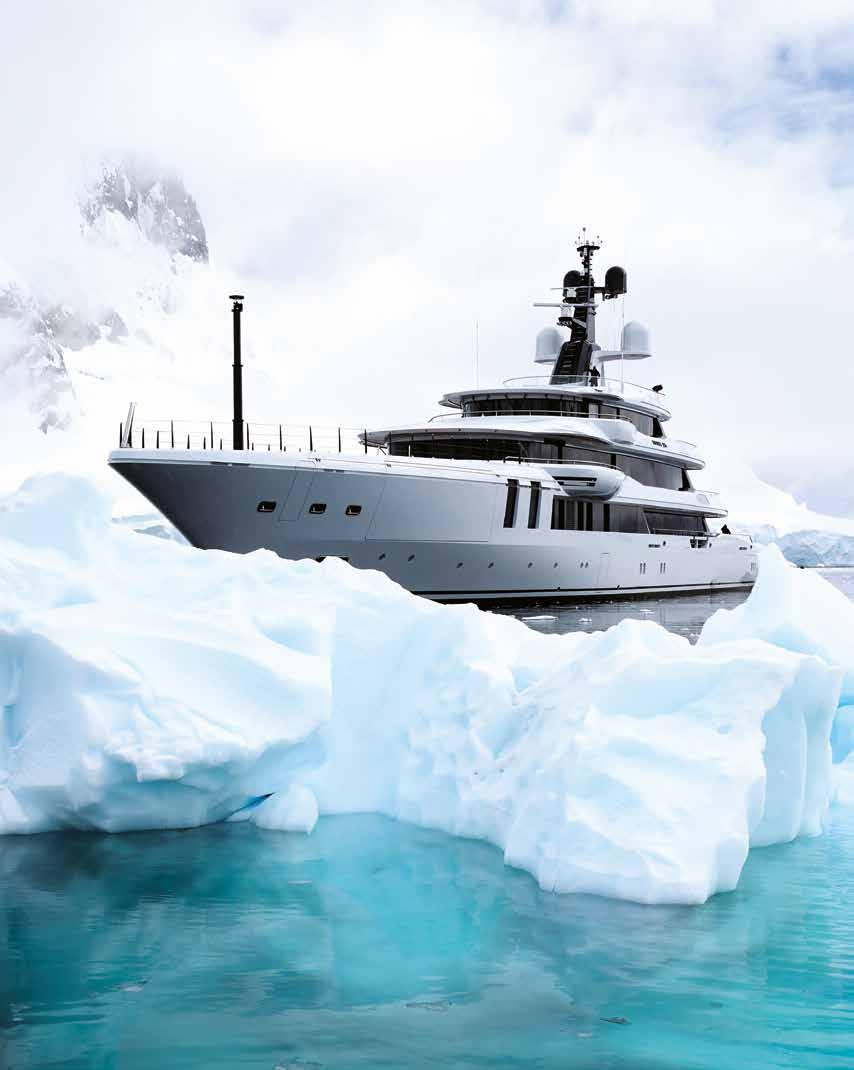
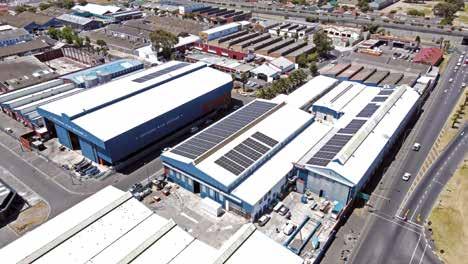

Southern Wind is one of many shipyards installing solar panels within their facilities. The yard also uses recycled PET core materials in construction.
ferent approach to reduce emissions by consolidating all of its staff at one location – in Pietarsaari, Finland. This strategic move is expected to result in reduced energy consumption and emissions as the shipyard will run less equipment such as lights and heating.
Many shipyards are also enhancing their business operations. For example, Lürssen’s energy-efficient refurbishments not only reduce energy consumption but also lower energy costs.
Baltic Yachts achieved a 10 per cent economic saving by switching to renewable energy supply. Additionally, wastereduction efforts contribute to reduced material costs. However, some of these benefits may be offset by the higher costs of alternative materials or improved products used.
The key question revolves around whether clients are willing to absorb additional costs in the pursuit of lifecycle and shipyard sustainability. As reduced impact practices become more widespread, uncertainties remain as to the effect this will have on the operational efficiency of the yards. Will they be incorporated into overall cost increases, such as those driven by inflation or changes in material supply, or will there be pushback from clients despite the efforts of the shipyards?
Ideally, clients will align with the trend seen among consumers generally, who are increasingly willing to pay for sustainability. For instance, a 2021 Deloitte study found that 67 per cent of participants were willing to pay up to 41 per cent more for products if they were sustainable.1
One critical aspect in this early stage of shipyard sustainability evaluation is understanding the impact of current actions. Feadship has established 2022 as its footprint baseline, while Southern Wind conducted a Life Cycle Assessment (LCA) on one of its builds, SW105-05 Sørvind, and its existing fleet to assess the environmental impact of its vessels from cradle to grave.
Once the current impacts are understood, it can inform the next steps. Charlotte van de Kerk, programme manager sustainability at Feadship, highlights the importance of using emissions data to make informed decisions that consider environmental impact in short- and long-term investments.

Paul Dumbell, planning and control manager at Southern Wind, explains that the LCA has helped clarify areas of increased impact. “I expected freight to have a high impact and electricity to be negligible, but freight turned out to be less than expected and the electricity we use in manufacturing is quite significant,” he says. This quest for understanding is also reflected in the research many yards are undertaking into viable alternatives for use in manufacturing.
Measuring baseline impacts not only allows for quantifying savings but also provides valuable data to be communicated in the future, thereby enhancing sustainability-related credentials. This communication is likely to take the form of reports published by shipyards, currently uncommon among new-build yards, although a few reports have been published by refit yards.
Drawing on lessons from industries further along in their sustainability journeys can help our industry catch up and accelerate sustainability efforts more rapidly. Another aspect to learn from these industries is how they ensure progress in these areas, mainly by integrating sustainability progression into the overall success of the business. This will involve continued measurement of various impact aspects and linking them to key performance indicators (KPIs) of the business.
With only six years until 2030, the gap between the current state of the industry and the goals that need to be achieved seems considerable.
Baltic Yachts has consolidated all of its staff into one location in Pietarsaari, Finland, as a different approach to reducing emissions.
While we await further details on Lürssen’s KPIs when it publishes its CSRD-related documents, Baltic Yachts has shared that its current KPIs focus on the energy usage of its facilities and specific pollutants such as volatile organic compound gases from certain products, such as paint used within the facilities. Efforts are also underway to include CO2 scope 1, 2 and 3 emissions in future KPIs.
Setting goals within a business is one aspect of progressing sustainability, but it’s equally crucial to invest appropriate time, resources and manpower into these efforts to ensure their attainment. This requires the support and advocacy of senior figures within shipyards. Shipyards employ various methods to facilitate this, including having a dedicated sustainability team, as at Baltic Yachts, or through the efforts of employees appointed to specific positions to address targets.
Achieving these goals and sharing them through published reports will not only demonstrate proactive action towards sustainability, but also address the growing demand for transparency surrounding sustainability efforts. As expectations rise for company sustainability credentials, openness in sharing this information becomes increasingly important. Moreover, such transparency fosters collaboration, whether with
By incorporating sustainability into their operations, shipyards can achieve impact savings and reduce the environmental footprint associated with the entire life cycle of superyachts, from cradle to gate.
suppliers, initiatives such as Water Revolution Foundation or with other shipyards.
Working together on these efforts could accelerate progress in shipyard sustainability, leading to increased impact reductions or faster timelines. Collaboration is key to driving meaningful change in the industry. Indeed, many sustainability efforts within the industry are aligned with the deadline of 2030, such as the Paris Agreement’s target of achieving a 43 per cent reduction in greenhouse-gas emissions by that year, as well as Feadship’s greenhouse-gasemissions-reduction target.
Feadship’s plan to achieve carbon neutrality involves extensive investments in new machinery, installation of smart systems, upgrades to lighting systems as well as optimisation of heating, cooling and ventilation systems. While these activities will undoubtedly reduce consumption and emissions, the broader objective also includes transitioning away from fossil fuels, which will require significantly more investment (and published data) in order to be realised and verified.
However, with only six years until 2030, the gap between the current state of the industry and the goals that need to be achieved seems considerable. There’s currently no clear pathway from where the industry stands now to where it needs to be by 2030 if it is to meet these ambitious targets.
It’s evident that shipyards have various avenues to progress sustainability
by adopting a holistic approach that encompasses operations beyond just improving the impact of yachts. By incorporating sustainability into their operations, yards can achieve impact savings and reduce the environmental footprint associated with the entire life cycle of superyachts, from cradle to gate.
There may be questions about whether the goals of individual shipyards will be ambitious enough to drive significant improvements, especially if renewable energy use falls short of reaching 100 per cent, as seen in other industries. Additionally, even if ideal scenarios are achieved, some avoidable impacts may persist, necessitating offsetting measures where relevant. Challenges such as material consumption will also be harder to address.
Despite being in the early stages of the sustainability journey, shipyards are focusing on understanding and researching strategies and actions to achieve unspecified goals. We can anticipate an acceleration in the publishing of formalised efforts and relevant information in the near future.
Observing how shipyards and the wider industry work to improve the impact of the early life of a superyacht will be fascinating, and the imperative is on us, as clients and observers, to look beyond the press releases. MH
1. Monitor Deloitte, Sustainability as a value driver – How sustainability elevates product innovation and price differentiation. December 2021.






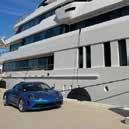
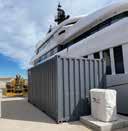

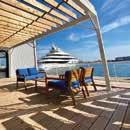

"Sète are going above and beyond to make our stay as simple as possible, and the facilities are exactly what we need this time of the year. Sète helped us accomplish more during our stay there than we did in the shipyard. The privacy and security and the surroundings are amazing!
What an amazing team, with a tireless work ethic and great personality. We really can't say enough about these guys. Kudos to your Sète team".

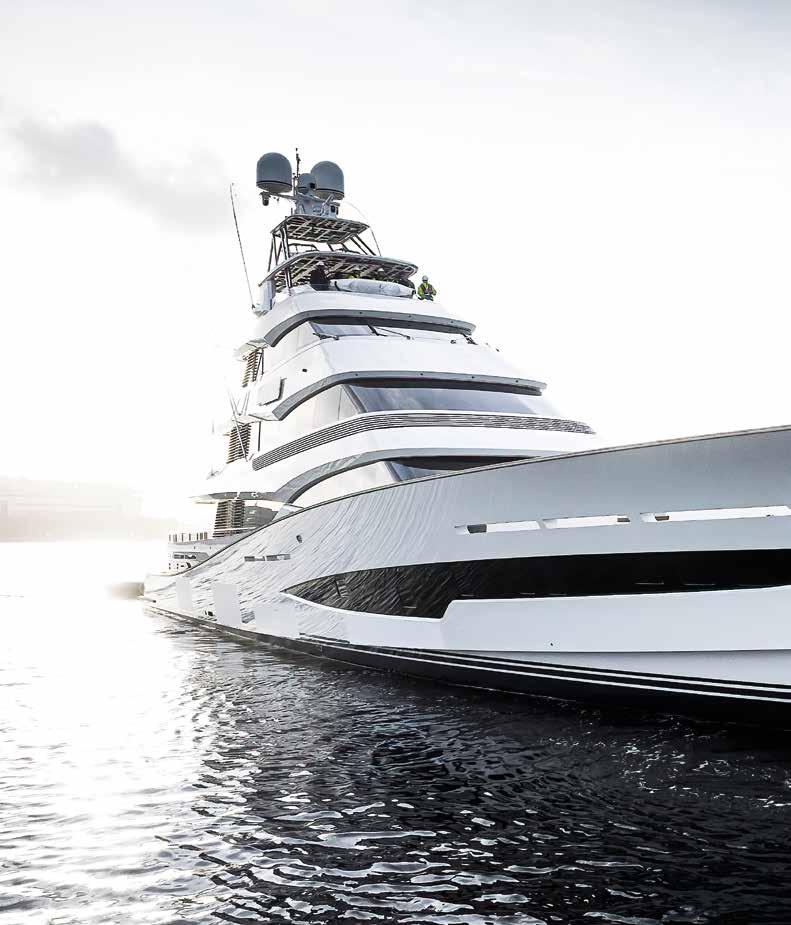



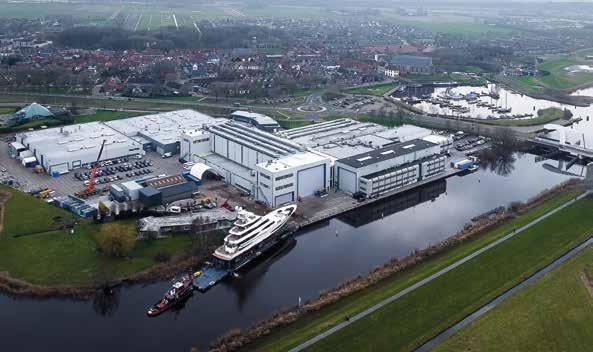
As the world’s largest sportfisher project hits the water, we discover what happens when a hyper-specific design brief meets a convention-busting shipyard.BY JACK HOGAN
As the editor of a superyacht magazine, in a space so perfectly positioned to marvel and excite, it’s with a heavy heart when I say it’s not that often that something comes across my desk that really does either. This can be especially true of mid-size motoryachts; there’s surprisingly little product variance in this size bracket.
This makes my job difficult at times. While the press releases may abound with superlatives, extolling virtues, as a writer with any conviction, it can be hard. Occasionally, however, something does appear that seems to be truly remarkable – a design that not only reimagines the form, but also the function of what defines a superyacht.
The term ‘superyacht’ itself is nebulous (see this issue’s Stern Words) – equally hard to define at the smaller end of the spectrum as it is becoming at the largest. The newest forays from luxury brands into the small ultra-high-end cruise market are blurring the lines, and the highly capable 24-30-metre yachts – one of which is covered in this edition –equally so.
One constant defining set of characteristics that does feel more immutable is that exhibited in the 50-70-metre size range: big enough to cross the world’s oceans and house a full-time crew of officers, interior crew and engineers, and at the same time dedicated exclusively to a family or small group of charterers.
These yachts are still inevitably designed around a similar operational profile. The ‘purpose’ of the majority of them is leisure and luxury, so it fits that they mostly come from a homogeneous design brief. It’s unrealistic and counterproductive to expect them not to. What is rare is to see real design considerations taken around something totally novel.
That's why it’s refreshing to see a yacht launched
that has a unique reason for being. While the owner’s team has kept relatively quiet about Project 406, shipyard Royal Huisman has said it is designed for an experienced owner who is passionate about fishing. This remarkable Alustar® aluminium motoryacht stakes its claim as the largest true sportfish yacht globally, boasting a towering profile spread across six decks and an impressive overall length of 52 metres.
Jan Timmerman, CEO of Royal Huisman, says, “Royal Huisman has built its reputation by fulfilling the most ambitious and challenging dreams of its clients. We create yachts of extraordinary individuality, with unrivalled levels of craftsmanship and reliability. It is a privilege to be selected by the owner’s team to realise this unique sportfish superyacht. We look forward to celebrating the launch of the finished product. Project 406 will be another masterpiece of creativity, innovation and expertise, uniquely embodying the essence of a Royal Huisman motoryacht.”
Dutch studio Vripack Yacht Design is responsible for the exterior and interior as well as the naval architecture of this ambitious project. The distinctive lines, with a long bow and high bulwarks sweeping through a clear sheer to a low and uncluttered cockpit aft, are akin to the sportfishing fleets of the US East Coast, sharing shape, if not scale, with the intrepid vessels traversing the wilds of the Central American Coast in search of sailfish and marlin.
The high tower, designed to give ultimate visibility and a separate conning station while stalking pelagic game fish, dominates the design profile, the same with the immense outriggers gracing the outboard aft on either side as well as the low-slung transom. The single game-fishing chair, the focal point of any serious sportfish vessel, sitting at the centre of the low-slung transom, is
Serious game-fishing requires equally serious design dedication, which is why Project 406 has been designed with the idiosyncrasies of game-fishing in mind. It needs to be because this tried and tested pastime requires integral operational considerations.
dwarfed by its surroundings, providing the clearest indicator that the scale of Project 406 is unlike anything on the water.
This is not to say blue-water game-fishing is unheard of on board superyachts. This usually casual, and sometimes not so casual, pastime for these yachts is a little spoken-about activity. However, many superyachts already try their hand at game-fishing, sometimes exclusively for the owner’s enjoyment.
The basics of deep-sea game-fishing are relatively simple, and on the surface, possible from a large motoryacht. I have trawled lures halfway round the world (with varying levels of success) on a range of 50-70-metre motor and sailing yachts. Fitting a rod holder and setting a small spread of lures behind a yacht travelling at 12 knots may be feasibly within the limits of game-fishing, but the reality of actually landing a fish is very different.
For starters, once hooked, the vessel needs to slow down quickly, ideally stop and, in some cases, even reverse to follow a large fish that is hell-bent on heading the other way. But that’s only the start of the problems. Lures may have to be trawled for hours before a hook-up happens. Sometimes a boat may have the luxury of keeping a deckhand permanently on watch, but even on a relatively chilled crossing, there’s still plenty of other work to be done.
The likelihood that anyone is watching the rods at the exact time that a fish is hooked is low. In the time it takes anyone to notice, let alone relay back to the bridge and start the slow slowdown process, the fish may have taken most, if not all, of the line from the reel. I remember many times returning to the aft deck to see an empty fishing reel, simmering suspiciously in its holder and stripped of its line, with a presumably perturbed
fish swimming away with a lure and 1,000 metres of nylon trailing from its mouth.
Serious game-fishing requires equally serious design dedication, which is why Project 406 has been designed with the idiosyncrasies of gamefishing in mind. It needs to be because this tried and tested pastime requires integral operational considerations.
Since its inception, the discerning owner of Project 406 has assembled a capable team to support Royal Huisman in bringing their vision to life. Expert advice from Bush & Noble on sportfishing and classic yacht forms, along with Hampshire Marine managing the day-to-day technical aspects at the shipyard, ensures a comprehensive approach to the project. Pascarelli Consulting acts as the owner’s representative, overseeing the project’s progress.
As Project 406 transitions from Royal Huisman’s Vollenhove facility to the vibrant heart of Amsterdam, it marks a pivotal moment in the unveiling of a vessel that reinterprets the essence of a luxury yacht. This 52-metre build is the culmination of high-end, purpose-driven design and engineering as well as a bold statement in the world of bespoke yachting. The yacht’s functional architecture, epitomised by its observation tower, is a design feat that melds the high demands of sportfishing with the elegance of superyacht living.
The tower’s strategic vantage point will offer more than just watching the spread of lures; it’s a special space from where owner and guests can survey the vastness of the ocean, a feature that underscores the dual-purpose nature of this unique project.
Project 406 stands as a testament to pushing the boundaries of custom-yacht creation, ready to sail as a pioneering vessel that will turn the heads of observers and game-fishers alike. JH
Leading provider of luxury outfitting for yachts, hotels, private aircrafts and homes.


We offer a complete customer experience with historical purchase information, billing and quotations. Enabling a simple reorder process and removing the need for multiple suppliers.
Reduce shipping costs by benefitting from our courier discounts. Pay lower prices utilising our bulk ordering buying power.


We can arrange storage and ship whenever it is convenient for you.
Our interior designers will help you with all aspects of a project. From reviewing the finer details to implementing a major refit.
Our graphic designers will assist with branding, logos and supporting artwork.
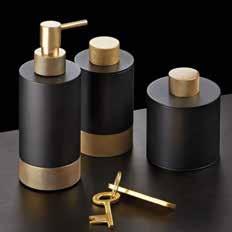

Backed by 20 years of experience in the yachting industry, we have the best brands, equipment and expertise available to deliver results for our clients.
Codecasa project manager Roberto Dalle Mura explains why they choose Jotun for their paintwork.
In the success of a company, investments play a key role and must always be accompanied by purposeful choices. When it comes to yachting and shipyards, the departments involved in the construction of a yacht are numerous, and for the success of the vessel, they need to be highly specialised. In this landscape, paint has gained importance, and today many companies have set their sights on high-end results.
Now, let us ask: why is paint so important? It is now generally agreed that the paint job on yachts is a crucial aspect of their beauty. Whether yachts are made of fibreglass, metal or any other construction type, a good paint job characterises their appearance, protects them from the marine environment and increases their value. Boats are constantly exposed to the elements and are subject to the corrosive action of salt spray, which can cause wear and tear over time. Careful painting can significantly extend the life of the boat, ensuring optimal conditions for many years and enabling the shipyard to meet the customer’s highest expectations for longevity.
We broached the subject with Roberto Dalle Mura, Codecasa project manager, to understand the choices of one of the world’s most renowned shipyards, which enters 2024 with nearly 200

years of history behind it. His opinion is that paint has taken on significant importance in boating and that executing it to perfection adds value to the boat.
During the launch, the beauty and brightness of the paint job are the first things that catch the eye, at a time when everyone’s expectations are high.
“This is why a good paint job has to turn out aesthetically and qualitatively perfect, and the effort and energy that go into this process are considerable.
During the staging phase, we optimise all processing procedures and follow up with the plasterers to ensure an optimal end result.”
Added to this is the importance of the

raw material: choosing the right supplier that ensures an excellent product is crucial, as is the know-how of the applicator who must be trained and thoroughly familiar with all the characteristics of the paints used. Among all the brands on the market, Codecasa has chosen Jotun products since 2020 thanks to the specific request of a shipowner who, after being fascinated by the colour of a yacht in the harbour, had decided he wanted it for his own as well.
“We initiated a lot of research and eventually discovered that the paint was Jotun’s Aquila White. We were impressed that the effect of the white was so beautiful that it looked like ceramic. From that moment, here at Codecasa Shipyard, we wanted to rely on the quality of Jotun products for all stages of painting: MegaCote, MegaFiller, MegaFiller Smooth, MegaPrimer, MegaPrimer Lite and MegaGloss AC.”
Choosing a paint product must take into consideration several variables: durability, colour, finish, application method and brand reputation. Dalle Mura emphasises that Codecasa’s choice was Jotun “also because of the customer service that employs skilled workers at the highest level. We have great confidence in them because their assistance is immediate. Their advisors are always available, and they come periodically to analyse the progress of the work. In a nutshell, I can say that Jotun has the best customer service.”
Jotun products will soon stand out on the new 24-metre Classic lines, the first unit of which was recently launched, and 34-metre Classic yacht. The other Codecasa vessels, already launched and painted with Jotun products, are 56-metre M/Y Framura and M/Y My Legacy, 58-metre M/Y Kathryn and the 43-metre M/Y Boji.
Is it time for a technological re-evaluation of mooring operations? The team at Rondal certainly thinks so. Here, we speak with managing director Harald Lubbinge and technical product specialist Ard Ritsema about their innovative captive mooring and self-contained mooring winch system.
BY JACK HOGANThe process of mooring is fundamental to maritime operations. It serves as the literal connection point with safe harbour, integral to peace of mind for operators and owners alike. It’s also one of the most dangerous hands-on operations on board.
As a large yacht is secured to a fixed dock, especially in high winds, deck crew are regularly handling large lines under enormous loads. Orders are barked across crowded radio channels, all with potentially dangerous consequences. Traditionally, this process is done using an array of deck capstans, elbow grease and thrusters. Once attached to the dock, these lines then need to be removed from the winch (capstan) that tensioned them and ‘bounced’ on to a bollard – mostly by hand.
Despite significant technological advancements across all aspects of onboard operations, mooring processes have remained a curiously analogue outlier. Checking the tension on lines is also primarily done visually. As tides and winds influence a yacht’s mooring, the safety of the vessel is gauged by eye and feel.
However, Rondal, a leading expert in custom captive winch design which has been producing captive winches for more than 30 years, is looking to modernise this aspect of deck operations by introducing a more advanced and safer mooring system for large motoryachts.
The company’s track record speaks volumes: Juliet, delivered in 1993, was the first yacht equipped with Rondal captive winches. Remarkably, the original winches are still on board, a testament to their enduring reliability. Juliet’s captain, Jonathan Allan, confirmed they have undergone minimal servicing over the years.
These winches have been installed on a large number of sailing superyachts from various shipyards since their
debut, and they have been continuously improved and developed over the years to become even better, ensuring unparalleled safety and efficiency in mooring operations.
“We had a motoryacht customer who saw our winches, which he had normally used for our sailing system, and he asked us if it could also be used for mooring,” says Rondal’s managing director Harald Lubbinge. “We were not specifically doing that at the time, but we had a meeting quite recently and have moved ahead to design a complete system.”
There is a regulatory catalyst for this development also. On 1 January, the International Maritime Organization (IMO) introduced revised SOLAS Regulation II-1/3-8 and associated guidelines aimed at enhancing safety and efficiency in towing and mooring operations. This update underscores the imperative for greater consideration of occupational safety and secure mooring when designing new vessels. As of 2024, mooring vessels more than 3,000gt will become a mandatory hands-off procedure, and for vessels of less than 3,000gt it’s strongly advised.
The amendments by the IMO Maritime Safety Committee emphasise key functional objectives for mooring systems, including minimising obstructed access, reducing manual handling and enhancing safety for personnel involved in mooring operations.
Rondal seeks to supply a complete mooring system that can integrate with yacht builders during the construction process. By focusing on the most efficient line running on board, whether electric or hydraulic winches, the system is designed to offer a more consolidated solution. When operating high loads entirely hands-free, it substantially reduces crew-safety risks and is cleaner and more precise. No cleating
“We had a motoryacht customer who saw our winches, which he had normally used for our sailing system, and he asked us if it could also be used for mooring. ”

is required, and when trimming the mooring line, no manual line-handling is needed, therefore ensuring safety.
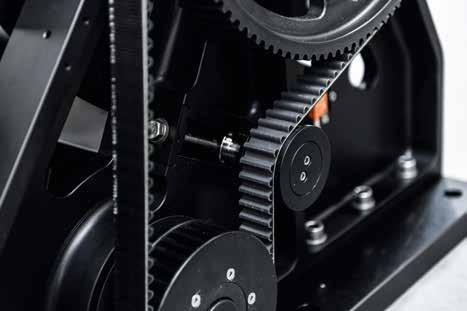
Two crewmembers, each with a local control unit, can split responsibilities for faster adjustment if preferred. Loads on all the winch sheaves are monitored and integrated with the ship’s AMS system. The system’s load capacities meet established classification requirements.
By installing the winches below deck and controlling them remotely, the system minimises the risk to crewmembers and ensures a clean deck layout. Moreover, sensors on the winches continuously monitor tension levels, providing real-time alerts and ensuring optimal safety and efficiency during mooring operations.
Captive drum winches, as seen left, are staples of the large sailing-yacht fleet for managing rigging and are an alternative solution that can be applied to mooring operations. Rondal has pioneered a self-contained and selfflaking system for yachts in the past.
“Our winches have quite a long drum where we can store lines and also pull the lines as needed,” says Rondal technical product specialist Ard Ritsema. “Our current motoryacht
Photo: Tom van Oossanen
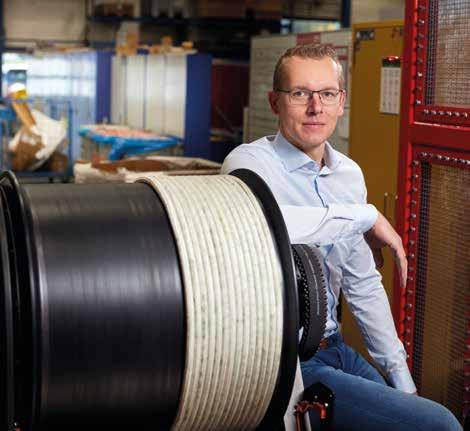 Top: Harald Lubbinge, Rondal managing director.
Below: Ard Ritsema, Rondal technical product specialist.
Photo: Bastiaan Musscher
Top: Harald Lubbinge, Rondal managing director.
Below: Ard Ritsema, Rondal technical product specialist.
Photo: Bastiaan Musscher
client wanted to have those winches operated remotely to avoid the tension getting off to the drum. They saw the benefit of having the system be safer and less interference between the line and the crew.”
The primary advantage of this is that it allows deck crew to stand at a safe distance controlling the lines. A crewmember theoretically only needs to handle the line if tension needs to be adjusted. This will be done by remote control, with no physical interaction during mooring. A sensor warns if the line is over-tensioned or if there is slack line, and a crewmember will then adjust the tension in the line by remote control but, otherwise, they can be at a safe distance. This will hopefully make life a lot easier for mooring purposes.
“We have sensors on the winches that measure tension on the line. If there’s too much tension, the system sends a signal to the yacht’s control system,” adds Ritsema. “The control system can then take action, such as adjusting the tension or alerting the crew if needed.”
To have such capability would be advantageous and a break from tradition. As any deck crew can attest, man-
One of the significant challenges encountered in mooring operations is dealing with overruns and ensuring quick tensioning, especially when retrieving slack lines.
handling heavy lines under tension is a stressful side of operations. Any system would need to have a lot of strength in the drum and its attachment point because it would be handling huge loads, which is why this system is fully integrated into the build process.
“The regulations have become stricter, especially for vessels above 3,000gt, where mooring systems are becoming mandatory,” says Lubbinge. “For vessels below 3,000gt, it’s highly advised to ensure safety and compliance with regulations. We want to continue to discuss further with classification societies how they see our system’s application over a wider range of the fleet.”
One of the significant challenges encountered in mooring operations is dealing with overruns and ensuring quick tensioning, especially when retrieving slack lines. However, Rondal’s system includes tensioners and sensors to detect slack lines and automatic tensioners to prevent such issues, thereby mitigating operational challenges. The tensioners avoid slack line on the drum of the winch but if there’s a slack line between the yacht and
the quay, the line can be tensioned by remote control.
Due to the wide range of available captive winches, the Rondal mooring system can benefit yachts of various sizes; larger motoryachts of 60 metresplus, with more space and heavier loads, stand to gain significantly from the added safety and automation. Additionally, compliance with stricter regulations, especially for vessels more than 3,000gt, further emphasises the importance of adopting innovative mooring solutions.
With encroaching regulations seeking to address a historically dangerous aspect of deck operations, a more technologically advanced and handsfree system presents an intriguing option for new builds. As the Rondal team, – as well as the regulations – lay out, this is likely to be employed by the 3,000gt-plus fleet initially, but with advancement in line technology, it may also be feasible for smaller yachts.
“Convention has dictated that we do it a certain way for centuries,” concludes Lubbinge. “But it may be time to bring this aspect of operations into the next generation.” JH
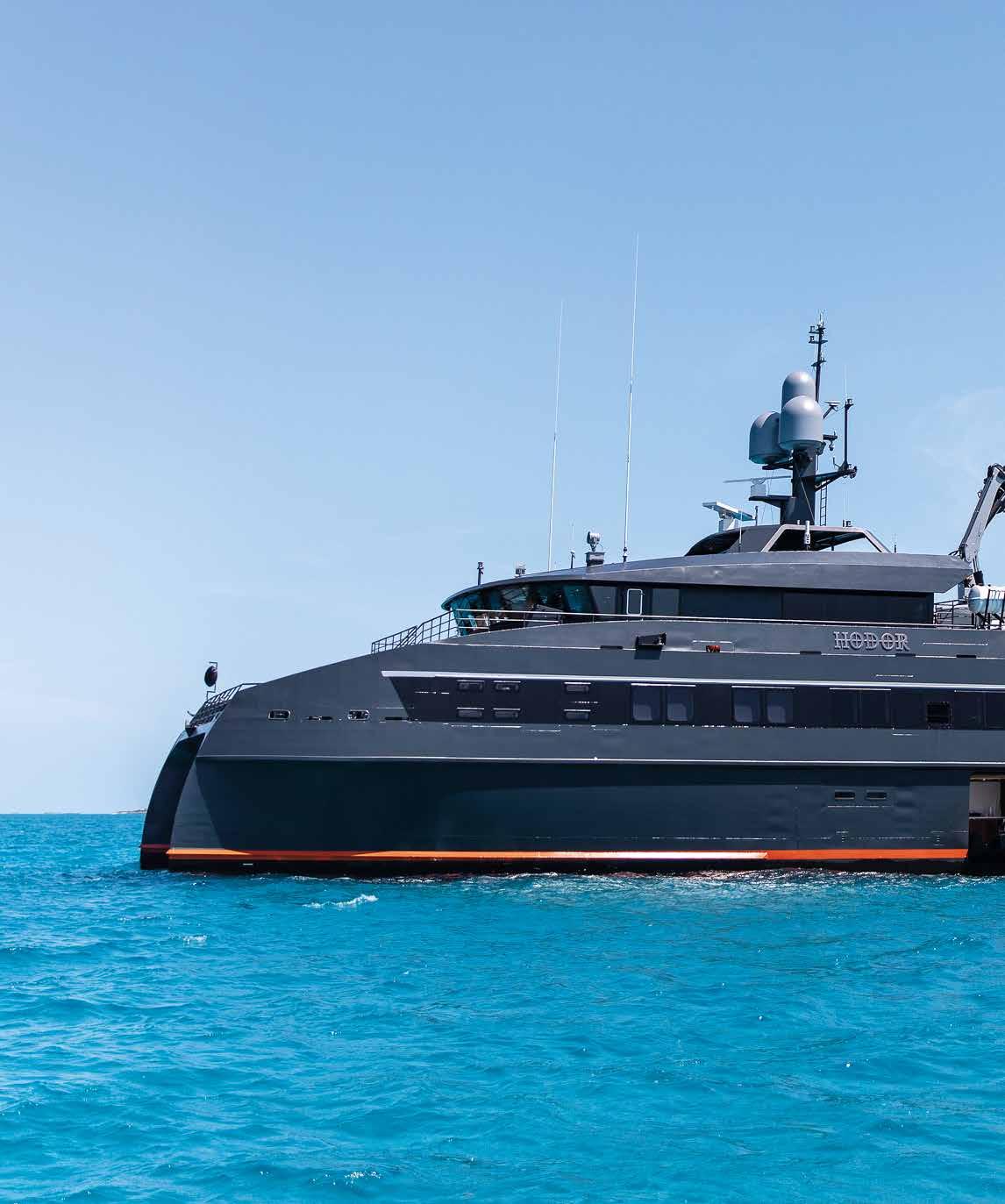
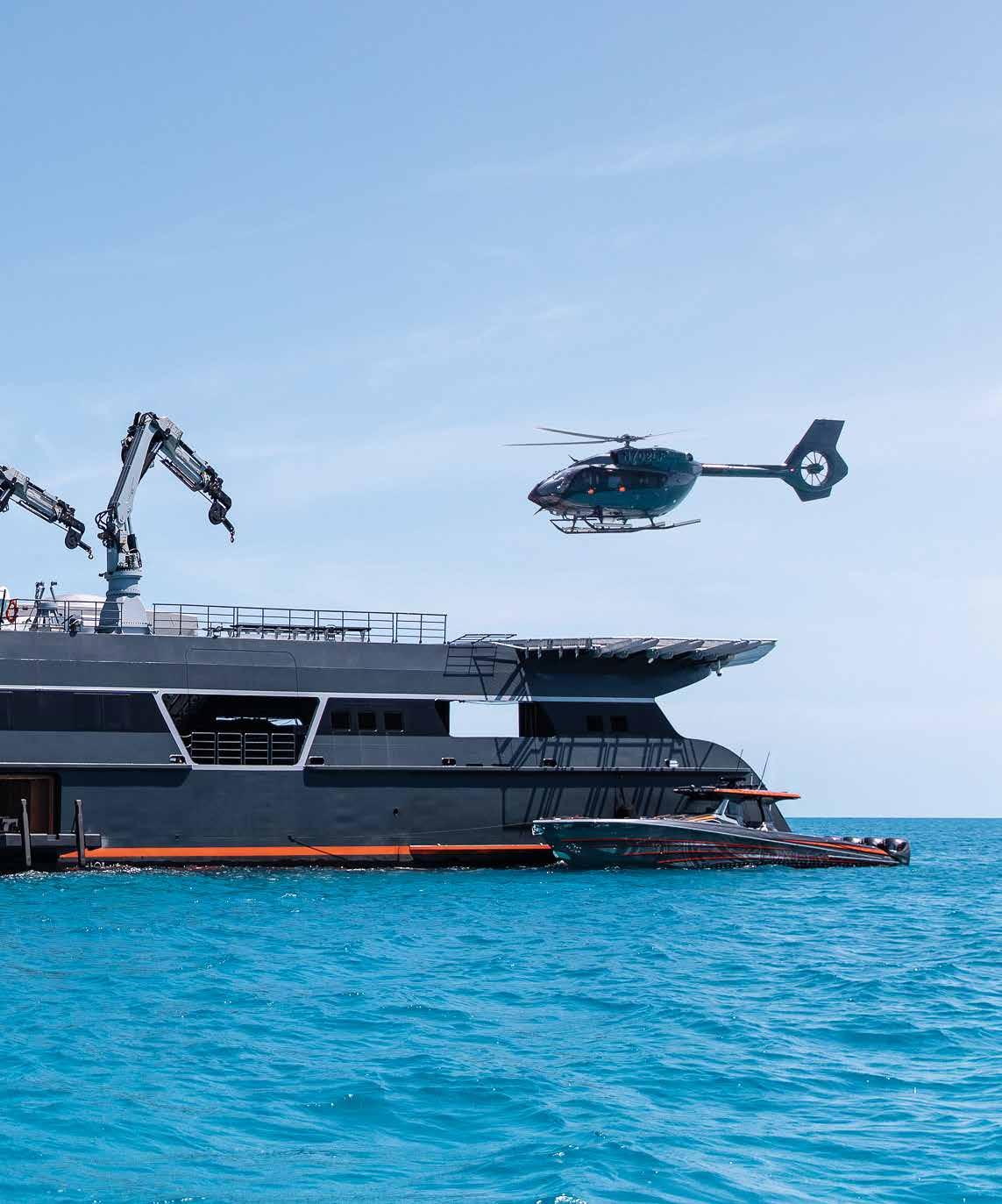
Monohulls still comprise the lion’s share of the fleet, but could large multihulls ever overcome current prejudices to become the new kings of the jungle?
Despite their allure with increased gross tonnage, greater fuel efficiency and enhanced stability, interest in large multi-hulls has been relatively slow, with most movement seen below 30 metres. Yes, there have been some famous launches in recent years and some seriously eyecatching support vessels joining the fleet, but multihull vessels are still rare gems, rarely seen in the superyacht sector.
So what factors have contributed to this cautious approach, what’s the potential of multihulls in the future of yachting, and what lessons can be learned from past launches in both the yachting and supportvessel sectors?
“There’s a slow uptake on the upper scale, which is ironic because you’d think the top shipbuilders would be more adventurous and cutting-edge,” says Jennifer Smith, director of business development at SHADOWCAT, a builder of large luxury multihull support vessels. “I think there are a few factors at play, with one of the bigger ones being operational resistance.
“While owners are excited enough to call us directly, once they involve their operational crew, enthusiasm tends to fade. This might be due to the inexperience of marine departments in handling large cats, which require different navigational approaches more common in the commercial sector.”
Multihulls aren’t a modern concept in the maritime industry by any means, and decades of research in commercial and naval marine sectors has been spent evaluating multihull platforms for various vessel types, sizes and speeds. James Roy, managing director of Lateral Naval Architects, explains that, as seasoned commercial catamaran designers, the firm first delivered a 38-metre catamaran superyacht in the early ’90s. “We thought that the then relatively infant superyacht industry would be in awe of this and many more would follow.”
However, the phone didn’t exactly ring off the hook, and big cats have never really gained any significant market share since. Roy adds that a few years after their 38-metre yacht’s delivery, the owner invited them on board. “While on the aft deck, he expressed his fondness for the yacht, but felt uneasy when berthed stern to alongside sleek monohulls with raked bows. The owner then pointed and said, ‘I want my yacht to look like that’. He was, of course, pointing to a monohull.”
We were surprised by this; from conversations at boat shows and in interviews, catamarans
had appeared to be rising in popularity – but the data says otherwise. According to Superyacht Intelligence, only 12 multihulls over 30 metres have been delivered since 2019, four of which are support vessels. The most recent deliveries of both yachts and support vessels have been Viaraggiobased Tecnomar’s 43-metre motoryacht This Is It and Australian shipyard Echo Yachts’ 56-metre Charley 2. Both are the largest catamarans built by their respective shipyards, with the latter being the biggest catamaran motoryacht ever built in Australia, representing a shift in construction methods towards multihulls, small though it may be.
Whether the slow uptake is down to a lack of operational or construction knowledge, infrastructure, education on their benefits or simply aesthetic hang-ups is unclear. What is clear, however, is that there’s a lot the superyacht industry can learn from the commercial and support-yacht sectors. Their adoption of multihull construction methods to increase useable space and stability on board, and boost fuel efficiency while reducing operational costs, are innovations to aspire to should the fleet wish to continue its evolution.
This is the key point to consider when discussing multihulls – their design enhances hydrodynamic efficiency in the water due to their slender hulls, meaning they require less engine power and fuel to achieve the same speed or range compared to traditional single-hull vessels. The same principles apply to trimarans, which consist of a long, slender central hull and two smaller outer hulls. This configuration acts as a stabilised monohull, with the outer hulls providing additional stability as well as enhanced hydrodynamic efficiency.
By dividing the displacement between two or more hulls, the length-to-displacement ratio is improved and, in turn, the wave-making component of the drag is substantially reduced. “Across much of the speed range of interest, the wave-making drag is the dominant component, and it is the length-to-displacement ratio which is the most influential variable,” explains Roy. “It is often cited that the benefit of the multihull is derived from the very slender hulls, as characterised by the visibly low waterline beam of each hull. However, this is a second order variable and it is length in relation to displacement which is the most influential.”
The disadvantage to dividing up the displacement, however, says Roy, is that it increases wetted surface area, leading to higher frictional drag. In
“I think there is a great coalescence between the faith of these new yacht owners and that product personality. They are sporty, they are active, they want to adventure. They want to embrace these things. And they’re a little bolder when it comes to taking risks and doing different things.”
 M/Y Charley 1 – 50-metre composite catamaran yacht support/adventure yacht, from Echo Yachts.
M/Y Charley 1 – 50-metre composite catamaran yacht support/adventure yacht, from Echo Yachts.
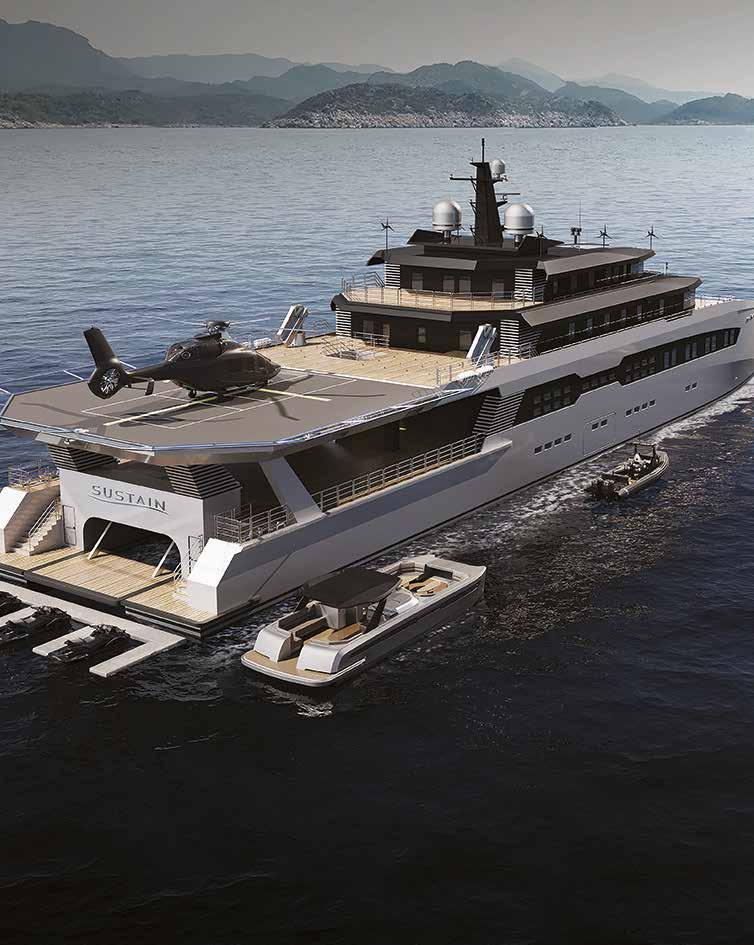

A trimaran rolls around a single longitudinal centre point like a monohull, providing stability and efficiency similar to a catamaran with the aesthetic appeal and motion similar to a traditional monohull, combining the best of both worlds.
segments of speed-to-length ratio where wavemaking drag dominates (moderate to higher speeds), the multihull will therefore be at an advantage, while in areas where frictional drag is dominant (low and very high speed) multihulls have a higher drag than a monohull. Multihulls also dsiplay wave interference effects from the component hulls, varying in effects on drag. But these effects tend to only be pronounced at lower speeds and heavier displacements.
They are also typically constructed from lighter materials such as aluminium, which reduces submerged hull area, minimising wetted surface area, and further reducing hydrodynamic drag and fuel consumption. For instance, compare a 92-metre monohull to Echo Yachts’ 84-metre White Rabbit Despite having a similar gross tonnage, the monohull requires 7.2mW of power to achieve a top speed of 19 knots. In contrast, White Rabbit needs only 4.2mW to reach 18.7 knots – towards a 40 per cent reduction of installed engine powering requirement, according to Echo Yachts’ sales and marketing manager Chris Blackwell. When considering that the industry has spoken extensively about its aspirations to decarbonise and adopt more environmentally friendly practices, multihulls present a compelling option.
“If everyone in the industry genuinely wants to make a really big dent in CO2 emissions and make yachts more environmentally friendly, while simultaneously lowering your fuel costs, catamarans and, moreover, trimarans are the way to go,” says Blackwell.
“We’ve made these boats more efficient from existing technologies. If the industry were to then integrate emerging solutions like hydrogen fuel cells and diesel-electric propulsion systems into our platform, it could enhance efficiency even further, beyond the 40 per cent benchmark.”
The stability of catamarans is often cited as a core factor in their appeal. With a monohull, whether you’re powering along or at anchor, there’s a distinct roll characteristic from port to starboard.
It’s a longitudinal motion that rolls back and forth. “However, with a catamaran, the motion is different. It’s a slightly more noticeable motion, shifting weight from one hull to the other,” says Blackwell. “While this is less noticeable when the catamaran is moving, it can be slightly more pronounced when anchored.”
Here is where trimarans offer a distinct advantage. As a stabilised monohull, a trimaran rolls around a single longitudinal centre point like a monohull, providing stability and efficiency similar to a catamaran with the aesthetic appeal and motion similar to a traditional monohull, combining the best of both worlds.
Looking to execute its multihull expertise, Lateral Naval Architects has unveiled Spear, an ambitious 140-metre trimaran project that aims to combine comfort, expansive open spaces and enhanced hydrodynamic efficiency and stability. By design, the relatively small sponsons contribute to a platform that needs little support from active stabilisation. The stabilised monohull concept introduces more advantages by also offering a spacious platform, with a 40 per cent increase in highly sought-after external space while keeping the internal area similar to a 110-metre monohull.
This lesson in stability is one best learned from the support-yacht sector. With the industry evolving, Robert Smith, CEO of SHADOWCAT, says there has been a notable shift towards clients buying smaller vessels and purchasing a shadow yacht to carry its tenders, with owners less willing to invest in a 100-metre yacht with its hefty operational expenses.
He adds, “This trend mirrors what we’ve observed in the support-vessel sector, where we’ve been involved for over 15 years. Building a 70-metre vessel allows access to the best ports and offers flexibility in terms of operations. If you look at what we did with Hodor, that was all about launching and recovering large tenders and heavy weights.
“It is so stable and has a much higher metacentric height [GM] than a mono hull, so it can handle the
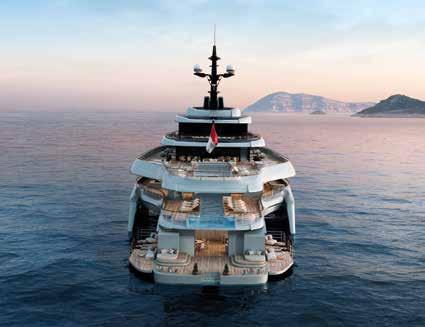
 Spear , Lateral Naval Architects' 140-metre trimaran project, which offers a 40 per cent increase external space while keeping the internal area similar to a 110-metre monohull.
Image: T. Fotiadis Design
Spear , Lateral Naval Architects' 140-metre trimaran project, which offers a 40 per cent increase external space while keeping the internal area similar to a 110-metre monohull.
Image: T. Fotiadis Design
transfer of these weights with no problem. Subs are becoming more popular, and these things can weigh up and over 10 tonnes, so that is why a catamaran platform is perfect.”
Choosing a catamaran for your support vessel is cost-effective too, with the idea of designing two smaller vessels together becoming more common to reduce both the footprint and operational expenses. According to Smith, several prospective buyers have opted for a different approach, however, and are looking to use a large multihull as their primary vessel.
It’s easy to see why, as when considering its efficiency and ocean-going capabilities, it also offers a wealth of useable space, typically a lot more than that of a monohull with the same LOA. In terms of space, the outdoor entertaining areas, abundant storage space for tenders and the enhanced potential for certified helicopter pads make catamarans and trimarans well-suited to the features preferred in a superyacht, not just a support vessel.
Their construction from aluminium also allows for a shallow draught, letting them to access more exotic and exclusive shallow locations that are typically inaccessible to heavier, deep steelconstructed monohulls. As for challenges in building multihulls compared to monohulls, catamarans often have two engine rooms, one on each side. While this set-up duplicates systems such as electrical, control and fuel, it also offers redundancy. In the event of damage to one engine room, the vessel can still operate with the other.
One of the primary challenges for multihull shipbuilders is to ensure the yacht’s structural integrity and stability.
“Aluminium fabrication also tends to be a little more challenging and requires a higher level of skill compared to steel. Aluminium welders can more easily transition to welding steel, but it’s more challenging for steel welders to adapt to welding aluminium,” explains Blackwell. “Unlike steel, aluminium can require more care in weld sequencing and other techniques to control plate distortion and
ensure a high quality result. However, this is only a challenge for companies that lack experience and proficiency with aluminium construction..”
So why hasn’t this transformative shift gained more traction? Firstly, the vast majority of the shipbuilding industry in Europe is structured around traditional shipbuilding operations and tends to favour steel or composite construction for large monohulls. More to the point, designers, shipyard workers and infrastructure are tailored to accommodate narrow, long yachts.
Some shipbuilders have sheds with a beam of 14 metres, so they couldn’t build a large cat even if they wanted to. This trepidation extends to berthing spaces too, with the limited availability of space in prime marinas already a cause for concern for thinner monohulls, let alone bulkier multihulls with larger areas. This can be mitigated with side-to berthing options in challenging marinas.
Secondly, people tend to shy away from unfamiliar concepts. This is perceivably one of the core factors behind big cats not being built, with some shipbuilders not being as adventurous in building large multihulls as opposed to the tried and tested construction methods of monohulls that they are accustomed to.
“A lot of people have died on the rocks trying to be a superyacht builder,” says Smith. “You may well have an owner who is willing to embrace something new, but then you have an operational or projectmanagement crew that doesn’t want to make a mistake. Everything hinges on the project going well, with little room for failure. We find the industry surprisingly risk-averse, and it is a big paradigm shift to go from a monohull to a cat.”
From a naval architecture perspective, cats and trimarans present a greater challenge with regard to seakeeping where their ability is severely limited compared with the monohull when looking at wetdeck clearance and stability. If this is too low, then slamming will begin to occur, necessitating a change in course and speed. “There is no easy way out of this; it needs a wet-deck clearance that is aligned to
From a naval architecture perspective, cats and trimarans present a greater challenge with regard to seakeeping where their ability is severely limited compared with the monohull when looking at wet-deck clearance and stability.
the operating wave height and this will push up the vessel’s profile, which designers don’t like, and is at odds with a well-proportioned design in the context of a yacht profile,” says Roy.
“In this case, the use of semi-swath hulls and ride control systems could help. If you went to a full Small Water Plane Twin Hull (SWATH) solution, then your seakeeping is probably better than a monohull. However, these platforms are very niche and suited to very limited and specific operating envelopes. When you try and apply the ‘I want to wake up and go anywhere I like’ operating profile of a modern yacht, they are not suitable.”
Aesthetic preferences may play a role too, with some potential buyers preferring the traditional look of monohulls. “We have one client who, like many representatives of yachting’s current clientele, is quite involved in the process,” says Smith. “In this case, it’s a husband and wife. They love the idea of having two yachts, almost like a his-and-hers arrangement.
“He was very into our catamarans, which have that sort of Mercedes G-Wagon robustness, broad shoulders, you’d almost call it. That’s not what she was interested in when bringing her girlfriends out for a weekend in the Caribbean. It just didn’t have that iconic big white boat look she was into.”
Disseminating the benefits of a big cat has also been challenging, and while catamarans have gained
slightly more recognition, trimarans are still relatively newer in the market. One of the most impressive multihulls over the past two decades is the 64-metre trimaran White Rabbit. This vessel garnered so much admiration that the larger 84-metre trimaran of the same name, mentioned earlier, was subsequently commissioned by the owner and developed by Echo Yachts with numerous improvements.
The Perth-based boat builder completed this project towards the end of 2018 and had a brief opportunity in early 2019 to showcase it at the Singapore Yacht Show. During the event, notable shipbuilding figures from the Damen and Lürssen shipyards in attendance.
“They stepped aboard and were very complimentary about what they saw, particularly looking at the combination of usable space, comfort and quality of construction ,” says Blackwell.
Despite the yacht going on to win numerous accolades and titles at award shows, Echo Yachts was hamstrung by the pandemic, with the lockdowns and the cancellation of events greatly impacting the shipyard’s promotional activities and overall exposure. With the vessel being harboured in Singapore, it isn’t as readily accessible as places such as Monaco or the US, where it could showcase what a large multihull superyacht has to offer to a broader audience.

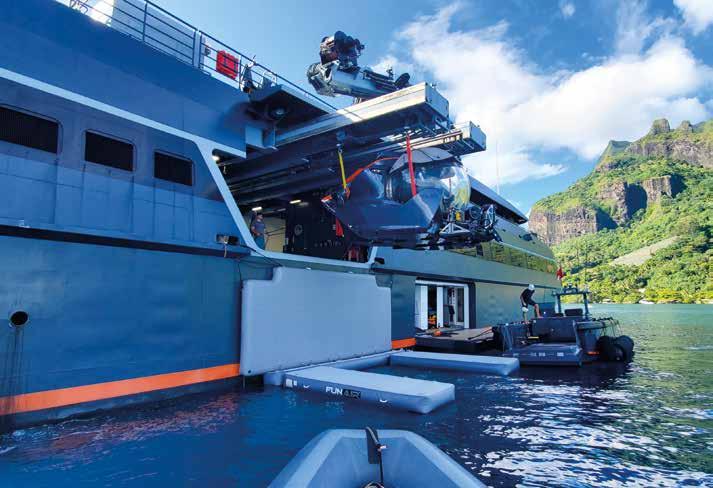
Choosing a catamaran for your support vessel is cost-effective, with the idea of designing two smaller vessels together becoming more common to reduce both the footprint and operational expenses.
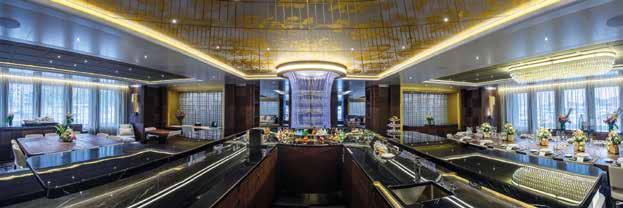
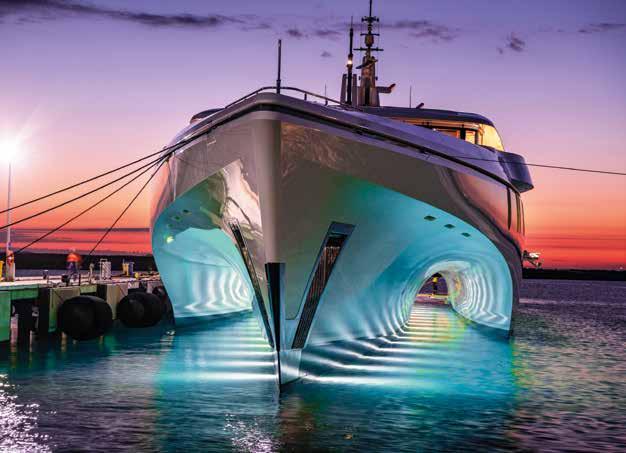
If the typical monohull is a Ferrari, the larger multihulls are G-Wagons – a safari vessel built for traversing any terrain in all conditions, but with all the customisation, luxury and comfort options you get with an Italian sports car.
However, in recent years, more owners, particularly younger ones, are beginning to recognise the benefits of multihulls as they step on board and experience them first-hand. Echo Yachts has showcased this again with its recent delivery of Charley 2, and also with its latest commission to build the world’s largest catamaran sailing superyacht, which will have an LOA of 57 metres upon completion.
As exposure continues to grow, so too will knowledge of the benefits of the big cats. “We have to get this exposure and understanding growing because the underlying reason for big cats not featuring on the market very often is that most captains and brokers around the world haven’t had the opportunity to step on board and experience them first hand,” adds Blackwell. “If they haven’t seen it, they tend to fear what they don’t know.”
The utilisation of space, greater stability and enhanced efficiency have become an increasingly attractive prospect for a variety of clients too, whether they are first-time buyers trying to find their sea legs or experienced owners looking to diversify their fleet and lower their operational costs.
“I think there is a great coalescence between the faith of these new yacht owners and the faith of an active yacht owner and that product personality,” says Smith. “They are sporty, they are active, they want to adventure. They want to embrace these things. And they’re a little bolder when it comes to taking risks and doing different things. We have several prospective buyers looking to use our platform as their primary yacht now, and I think these are the reasons why we’ve got in development what we have.”
The aesthetics of the big cats may not be for everyone; they are broad, bulky and built for the open seas as much as they are able to cruise into shallow Caribbean coves. If the typical monohull is a Ferrari, the larger multihulls are G-Wagons – a safari vessel
built for traversing any terrain in all conditions, but with all the customisation, luxury and comfort options you get with an Italian sports car.
And of course, there are also drawbacks in an operational sense, specifically when looking at their roles as superyachts. “We have done quite a few studies for clients analysing what is best. What we tend to find is you can make a quantified case for a multihull by analytical means based on efficiency. But when you look at the qualitative operational aspects of a multihull compared to a monohull, they do not suit yacht operation so well, taking balanced consideration across a wide range of operational factors. The monohull tends to dominate because it offers the best compromise of everything,” says Roy. “Having said that, it could just take one person to do a big multi-hull yacht really well to see others follow. All the technology is there and well-established.”
Whether or not multihulls will revolutionise the industry in the next decade is up for debate, but it’s certainly possible, especially when looking at their numerous advantages in efficiency, stability and versatility. And as more owners and builders become aware of their benefits, we may see a significant increase in their adoption in the coming years. Inescapably perhaps, there is always the perceived risk of doing something other than the normal monohull. In practice buyers want to be unique, but only up to a point.
The challenge lies in educating the industry about these innovations, and finding the balance between fuel efficiency, increased stability, greater usable space and not compromising what makes yachting enjoyable in the first place. It’s all a process of gradual education and acceptance within the new-build community and one that could lead to a different face of the industry in the years to come. Until then, the monohull remains king of the jungle … at least for now. CF
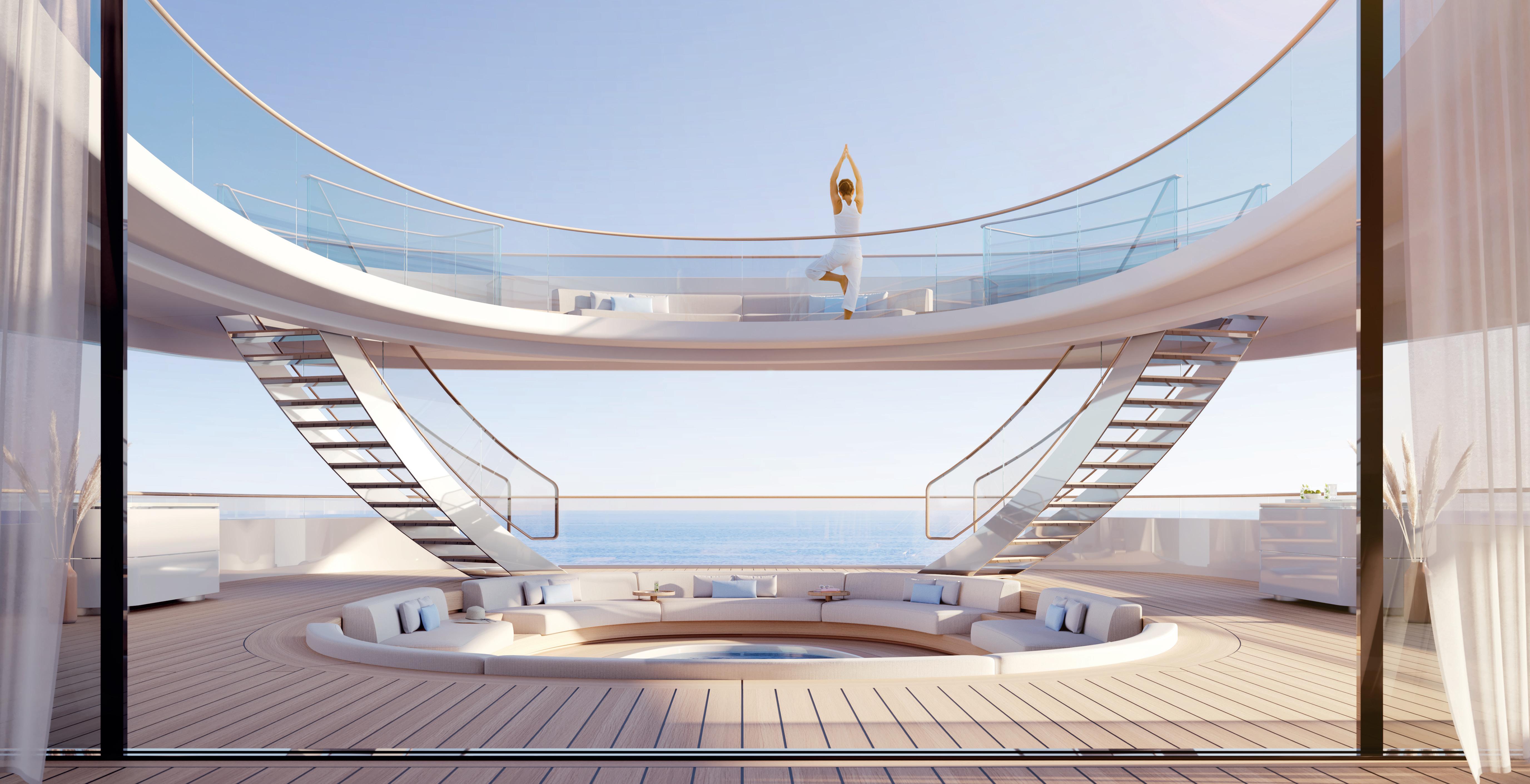
There are yachts and there are Feadships.

Celebrating its 40th anniversary, the Palma International Boat Show (PIBS) and Superyacht Village (SYV) are gearing up to set the maritime world abuzz in Palma de Mallorca from 25 to 28 April, 2024. The season-opening event, located at the picturesque Moll Vell, nestled at the foot of the cathedral, converges boat builders, brokerage houses, marine technology and the Mediterranean luxury lifestyle. This year, with even more events surrounding the show, including conferences and exclusive networking opportunities, it promises to be the most successful event in the show's history.
This year at the Superyacht Village and PIBS, 271 nautical companies will exhibit, and the show hosts upwards of 32,000 visitors throughout four days, steadily growing into an epicentre of industry connectivity in the Med. The meeting of yachting professionals and enthusiasts provides a unique platform for businesses to forge alliances, discuss innovations, navigate the future of yachting, and crucially for buyers to inspect and purchase yachts that can be on the water in time for the summer season.
For prospective buyers, charterers and

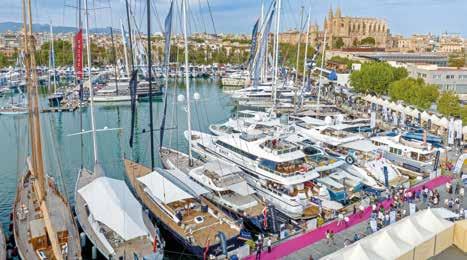
brokers, the Palma Superyacht Village is a unique opportunity to meet, visit the 80plus fleet of vessels on display, sea trial, potentially enter a contract, and cruise the Med in time for the coming season. In this regard, Palma offers a unique value proposition in what traditionally is the busiest sales period of the year for the brokerage market.
This year, the Superyacht Village sees the return of the ever-popular Refit & Repair zone, an expanded Yachting Ventures Innovation Corner where their most innovative nautical start-ups showcase their fledgling businesses, and the inaugural Mallorca Yachting Summit providing fertile ground for industry professionals to delve into innovative solutions, discuss sustainable practices, and gain valuable insights.
A pivotal event and new this year to the Palma International Boat Show is The Balearic Superyacht Forum. Organised by the Balearic Marine Cluster, IDI, and the collaboration of The Superyacht Group, this international superyacht forum spans 24 to 25 April. The Forum’s agenda promises a captivating exploration of
innovation, sustainability and the evolution of Palma’s nautical repair and refit industry. Experts and professionals will engage in dynamic discussions on the opportunities and challenges facing the Balearic Islands as an international superyacht hub.
Emphasising sustainability is a defining feature of PIBS and SYV, aligning with the evolving values of the yachting community. Initiatives to measure the carbon footprint, efficient waste management and responsible water consumption demonstrate a commitment to a sustainable future. This resonates not just with individuals but also with businesses seeking partners with shared values and an outlook for the future of the superyacht industry.
In the ever-packed yacht show calendar, Palma International Boat Show and Superyacht Village stand as pioneers, continually evolving and leading the charge towards a more sustainable and connected future. As they celebrate four decades of nautical excellence, positioned to advance the industry, the 2024 edition promises to be a platform to build alliances, transact and communicate innovative ideas for a flourishing superyacht community.
We look at how the key stakeholders in the Italian new-build market are addressing the shrinking pool of skilled workers across their facilities and, by doing so, preserving the legacy of the country’s tradition and innovation in the marine sector.
There was never any need for indepth market analysis to immediately understand the significant impact the pandemic, albeit indirectly, has had on the yachting market. In Italy alone, the overall turnover (including newly built units plus refit, repair and garaging activities) of the pleasure-craft sector rose from €6.11 billion in 2021 to an impressive €7.33 billion in 2022 – a 20 per cent increase.
The importance of this historic moment is clear. According to Confindustria Nautica, the institutional voice of the Italian marine industry, in 2023/2024, one out of every two Italian companies is indicating growth in turnover.
It’s evident that the Italian yachting industry generates resources and wealth, and deserves encouragement and promotion. With its current employment of 200,000 people and a real prospect of growth, it’s necessary for all stakeholders to envisage significant investments aimed at fostering the development of increasingly specialised professional roles.
In industries such as the nautical sector, it’s always a struggle to find qualified personnel capable of the quality workmanship that can represent Italian excellence globally, especially given that major Italian shipyards have their order portfolios full through 2027 and 2028. This is a significant issue affect-
ing the country, often highlighted at various boat shows where field experts voice the need for a solution.
The efforts to address this problem primarily stem from the most affected stakeholders, namely the shipyards themselves. In recent years, these initiatives have involved nautical institutes and the Italian Merchant Marine Academy, with prominent industry leaders actively participating in, or directly organising, specialised training courses across all levels.
In fact, this approach appeared to everyone as the most effective means of addressing the personnel shortage. Ensuring high-level training, providing access to prestigious courses taught by highly qualified instructors, and offering young people opportunities to enter the world of boating through renowned and engaging programmes represent the initial steps in sustaining one of the country’s most prosperous industries.
Evidence of how significantly the shortage of qualified personnel is affecting the yachting industry is the involvement in long-term training projects of managers, craftsmen, technicians, designers and shipboard personnel across multiple shipyards. Their insights offer a thorough understanding of the situation and underscore a pivotal moment for the industry.
This sector, perpetually engaged in daily challenges, has demonstrated a commitment to sustainability and strives to elevate the excellence of ‘Made in Italy’ to customers.
The Sanlorenzo shipyard was among the first to recognise the usefulness and the decisive return in terms of development that such initiatives could bring. In 2018, it founded its academy as part of a collaboration with the Liguria region, aiming to establish a training project that guarantees 90 per cent of hires after an apprenticeship period.
The project involves people with a diverse range of skills, including boat leaders, service workers, sailors and
project managers. In 2022, the project underwent expansion with the arrival of Pier Francesco Acquaviva as the group’s HR director.
Santi Carlino, chief people and ICT officer at Azimut|Benetti Group, also spoke to us about the understaffing problem, and its training school aimed at educating highly specialised personnel. The goal is to provide clients with the assurance of top-level skills across all sectors, resulting in a blend of services that culminate in an excellent product, and ensuring a level of employment that is good for the shipyards, the market and the country.
In another initiative, the Ferretti Group’s School of Trades targets young talented people in the 18-30 age range. This aligns with the landscape of shipyards that aim to solve the labour short-`age problem in the yachting industry by focusing on innovation and recognising the importance of training. Officina Baglietto similarly aims to perpetuate the nautical tradition for future generations.
What these worksites are proposing is to solve the understaffing problem by investing in training. At Sanlorenzo, its academy is structured along three main lines, and the first focuses on internal training. Acquaviva explains, “In the first pillar of the academy, which involves more than 750 people, there are mostly white-collar workers, with 50 per cent being millennials and the socalled ‘digitarians’ possessing important professional skills such as designers, architects, and communication and marketing specialists.”
Expanding on substantial investments in both upskilling and reskilling, Sanlorenzo’s initiative encompasses a managerial development programme tailored for people managers across its three core business units: the yacht business unit, the superyacht business unit and the Bluegame brand.
This strategic endeavour sees the establishment of partnerships with
Sanlorenzo’s comprehensive programme spans 200 hours of training, culminating in an internship.
Impressively, 90 per cent of participants secure permanent employment following the internship.
prestigious business schools such as ESCP – similarly utilised by Azimut| Benetti. Sanlorenzo has launched MBA modules catering to 22 people, aiming to equip them with essential elements of general management while facilitating networking opportunities beyond the yachting sphere, therefore ensuring significant value addition to the course.
The programme’s second pillar revolves around the perennial theme of the Sanlorenzo Academy, which annually invites applications for various roles. The current initiative, dubbed the ‘Yachting Operation Specialist’, targets those aged 18 to 35. This comprehensive programme spans 200 hours of training, delivered by both internal and external experts, culminating in an internship.
Impressively, 90 per cent of participants secure permanent employ-ment following the internship. In the pipeline for 2024 are two additional calls focusing on roles crucial to Sanlorenzo’s charter fleet: boat managers, akin to project managers, and crewmembers – aligning with client demands for well-trained crew.
The third and final pillar centres on training contracting firms, with Sanlorenzo forging tangible partnerships through a strategy of vertical integration. “Prominent Italian firms like Duerre, Carpensalda and Sea Energy are key collaborators,” says Acquaviva. “Moreover, we’ve recently enhanced our contractual framework to bridge the gap between training and cultural integration.”
This initiative includes the establishment of cultural mediation desks at all worksites, offering support to workers – many of whom are foreign nationals –alongside language and civic education courses to facilitate seamless integration into the community.
Sanlorenzo’s holistic approach to workforce development underscores its commitment to excellence and innovation, ensuring a skilled talent pool capable of meeting evolving industry
demands while fostering inclusive practices for a diverse workforce.
These initiatives are part of a series of measures aimed at enhancing workers’ skill levels, regardless of their current proficiency. In light of recent developments, one might ponder whether the investment in the academy stems solely from the boating boom of the past three years or if other factors are also at play.
Acquaviva recalls that a few years ago, a study by the World Economic Forum highlighted the significant transformation of job scenarios over the course of a person’s education. By the end of their studies, more than 50 per cent of professions either no longer existed or had undergone substantial transformation.
“The issue of continuous learning and retraining becomes crucial for the individual and consequently for the
 Pier Francesco Acquaviva, Sanlorenzo HR director.
Pier Francesco Acquaviva, Sanlorenzo HR director.
company,” says Acquaviva. “A month ago, the Ministry of Labour published alarming data regarding the expected decline in the number of working-age individuals in the coming years.”
Added to this is the problem of the large number of resignations, and it’s for these reasons that training becomes a crucial element in ensuring that a company has a pool of human capital on which it can rely. In addition, younger people today are demanding that they be assured of skill development, and so training becomes a key element of retention.
Training in foreign languages also fits into this. Acquaviva highlights that in the training framework aimed at retention, one important element is the online platform on which to conduct one-to-one lessons with English-speaking lecturers.
“In this project, it is also possible to have support in preparing possible presentations to bring to the attention of shipowners or to be included in the organisation of boat shows,” says Acquaviva. “In December 2021, our Italian head count stood at 575 people.” To date, Acquaviva’s new project is about defining the soft skills model that pertains to role management within the organisation, going beyond results and focusing on how to achieve them.
In June 2023, the Azimut/Benetti Group launched a real training school, based on the sharing of values and skills, which aims to improve professionalism and works on two very specific tracks from inside and outside the company that converge in a single goal: that of training highly specialised personnel in every field.
“This is an experiment that aims to differentiate itself within a targeted completion framework,” explains Carlino. “The academy logo speaks volumes: a propeller symbolising propulsion, composed of four blades representing four distinct segments.”
The first segment is the Shipyard Academy, focusing on building and transferring technical expertise throughout the production chain. It seeks to establish a generational bridge, facilitating the transfer of knowledge from seasoned professionals to the younger generation.
Conversely, the Managerial Academy encompasses expertise in leadership,

Santi Carlino, chief people and ICT officer, Azimut Benetti Group.
“We orchestrate structured engagements with educational institutions, offering guidance and internship opportunities, laying the groundwork for a proactive approach to talent acquisition.”
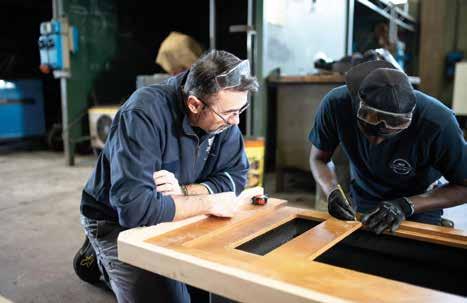

offering a comprehensive understanding of systems, strategic overview, people management and effective communication. Additionally, it delves into customer experience and executive education, aiming to forge partnerships with external entities to enhance crossfunctional collaboration. The organisation believes that exposure to external perspectives can greatly accelerate learning and innovation.
In the realm of developmental endeavours, Carlino sheds light on the Institutional Career Plan, a strategic initiative encompassing various projects. One noteworthy collaboration is with ESCP Business School, focusing on advancing higher education opportunities. “Our joint venture aims to facilitate real master’s programmes for twelve individuals,” says Carlino, who emphasises the significance of broadening experiential horizons and fostering cross-comparison with diverse realities. He also underscores the importance of tailored training aligned with contemporary objectives.
Another pivotal aspect of this initiative is dedicated to empowering young talents through educational and orientation projects. Carlino adds, “We orchestrate structured engagements with educational institutions, offering guidance and internship opportunities, laying the groundwork for a proactive approach to talent acquisition.”
Collaborations with institutions such as Isyl in Viareggio, the San Carlo Institute in Turin and the Naval Technical Institute in Savona underpin a concerted effort to establish a network rooted in their organisational ethos.
“We prioritise early engagement with aspiring talents,” says Carlino, outlining a strategy aimed at pre-emptive recruitment even before the culmination of their academic pursuits. This forwardthinking approach underscores their commitment to nurturing talent and fostering symbiotic relationships within the educational landscape.
Ferretti Group also stands out as a key player in tackling the issue of understaffing within this sector. Through its dedicated School of Trades, Ferretti Group endeavours to equip young people with the necessary skills to pursue promising career paths and foster professional growth.
This initiative, blending theoretical
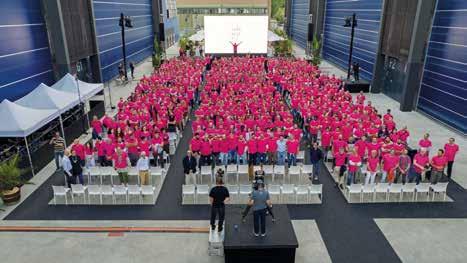
These endeavours reflect a broader trend of strategic investments and unwavering commitment among Italian shipyards towards maintaining the esteemed ‘Made in Italy’ brand.
knowledge with practical experience, aims to attract young talent keen to explore a field ripe with career opportunities, job prospects and global connections. Catering to those aged between 18 and 30, the project’s inaugural edition commenced in March 2023, enrolling 11 participants.
The curriculum encompasses various professions synonymous with the excellence of Italian craftsmanship in the yachting industry, including nautical carpentry, upholstery and mechanics. Over the 500-hour course, participants receive classroom instruction from seasoned managers and technical experts with first-hand experience at Ferretti Group, ensuring the transfer of specialised knowledge honed through years of practical engagement. Subsequent sessions were conducted over the ensuing months, focusing on carpentry and mechanical disciplines.
Structured as quarterly paid internships, these courses offer participants the opportunity to gain hands-on experience, with the most promising students earning employment contracts with the company. Given these auspicious beginnings and tangible outcomes, it becomes evident that addressing the staffing shortfall is an imperative that the Italian yachting industry cannot afford to overlook.
Similarly, the Baglietto Group endeavours to preserve nautical tradition through its dedicated workshop
initiative. CEO Diego Michele Deprati says there is a critical need for sustained investment in training initiatives, and cautions against the erosion of artisanal skills vital to the industry’s heritage. “Our collective responsibility lies in safeguarding these time-honoured crafts,” adds Deprati, highlighting the imperative of institutional support in addressing industry-wide staffing challenges.
These endeavours reflect a broader trend of strategic investments and unwavering commitment among Italian shipyards towards maintaining the esteemed ‘Made in Italy’ brand. Recognising the intrinsic value of specialisation and professionalism, industry stakeholders are all too aware of the pivotal role of training in upholding global standards of excellence.
“Training is our compass for navigating the ever-evolving seascape of the industry,” says a Baglietto Group spokesperson, underscoring the symbiotic relationship between tradition and innovation in the Italian nautical sector.
In essence, these initiatives underscore a collective resolve to uphold the legacy of Italian craftsmanship while simultaneously embracing innovation and progress. By investing in the next generation of talent and fostering a culture of continuous learning, Italian shipyards are poised to reinforce their position as global leaders in the nautical industry. DS
Sanlorenzo – on ‘the road to 2030’.
Technical director Jim Mair and build captain Ben Bowley give the rundown on the latest Arksen as the rugged explorer yacht awaits its maiden journey to the Mediterranean.

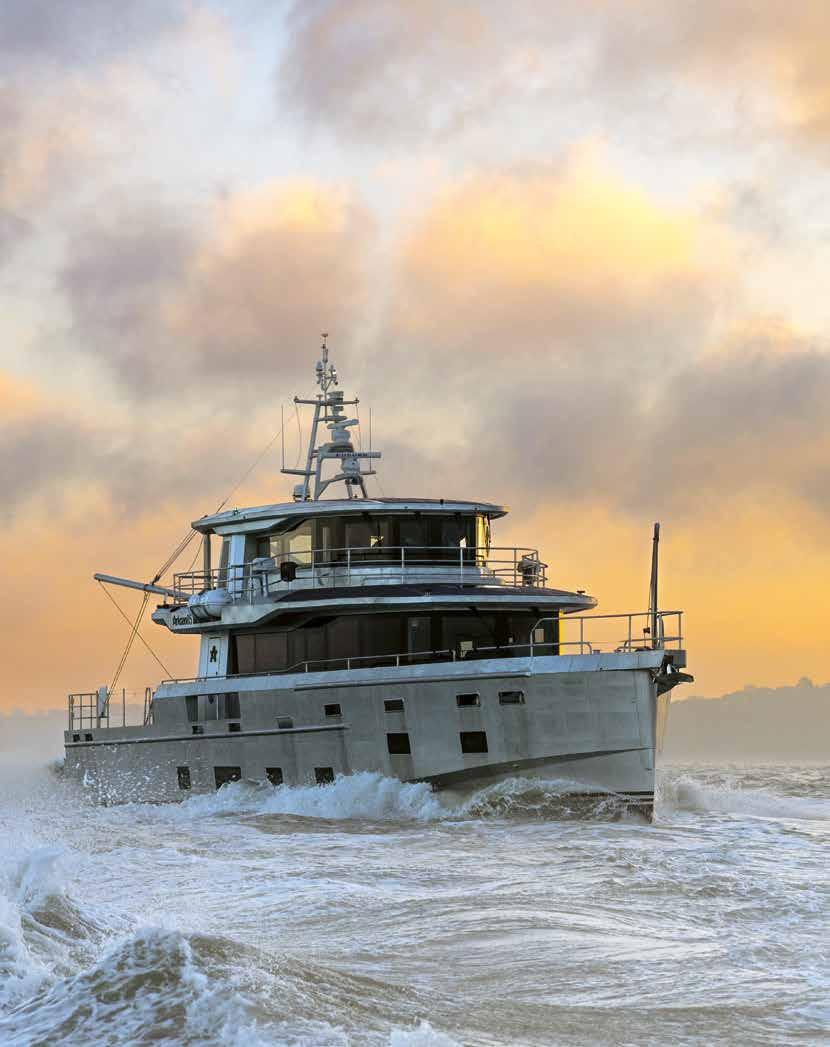
Arksen 85 has been designed with consideration as to how scientific expeditions can be carried out on board – as part of the ethos of the company and to allow owners to facilitate scientific activities.
BY MEGAN HICKLINGArksen 85 was created with efficiency, comfort and safety at its core … and all five years of research and development, design and production shine through its well-considered smart construction.
The customisable 85-foot aluminium explorer yacht is both very efficient and self-sufficient, built to withstand various worst-case scenarios. One has already been launched, with another launching summer 2024.
Arksen technical director Jim Mair recalls the origin of this bespoke project when the company’s founder, Jasper Smith, while on a boat in Greenland with his son, posed the question, “If you’re going to design the ultimate explorer boat to be able to go anywhere in the world, do adventurous things with minimal impact, what would it be?” Five years of considered design and planning later have culminated in a robust and luxurious explorer yacht.
This yacht boasts impressive specs for its size; the strong lightweight aluminium hull has been designed to be both very fuel-efficient and resilient. The top speed is 14 knots, but at its lower cruising speed of nine knots, the yacht achieves a range of 7,000nm in moderate sea conditions, consuming 25l/hr of diesel fuel. The yacht’s performance at sea trials exceeded expectations from the extensive hull-design process.
Part of this procedure involved tank model testing by Humphreys Yacht Design, with the Wolfson Unit at Haslar Marine Technology Park, based near Portsmouth in the UK. Towing tank tests are where a scale model of the hull is moved through a specifically designed tank, at different speeds, in flat water and waves, to measure resistance and simulate seakeeping in different sea conditions. The same model was also configured for self-propelled testing in an open basin, where it was driven at a range of speeds and headings, in a variety of wave spectra. This allowed for measurements and observations
of the handling behaviour and performance of the vessel.
The results of these tests can be used within the design process to more accurately estimate the power needed for the vessel. A better understanding of the stability and hydrodynamic characteristics of the vessel in the chosen simulated sea states, which represent typical or atypical (in the case of rougher seas, potentially involving freak waves), can inform naval architects of potential changes to the design of the yacht that would improve its performance.
Arksen 85 is made entirely of bare aluminium, giving it a rugged exterior that suits its explorer yacht purpose. Arksen and Humphreys Yacht Design deliberately selected lightweight, yet robust, aluminium to craft an exceptionally fuel-efficient explorer yacht. The bare aluminium hull, because of its corrosive-resistant nature, means less maintenance is required to the exterior and there is reduced weight from the filler and coating needed in other material hulls.
This is compounded by the fact that aluminium is fundamentally very strong for its weight, assisting with the creation of a very lightweight and, therefore, efficient hull. Aluminium is about onethird of the density of steel while having approximately two-thirds of the strength.
In designing this vessel, Arksen set a certain weight limit for this hull form. Typically, any excess structural weight allowance is used to further reinforce critical load-carrying structures and equipment, such as mooring, anchoring and lifting equipment to further increase the general robustness of the vessel and the owner’s peace of mind.
Enhancing its versatility, the vessel is offered with options for either features a serial hybrid system or a conventional twin diesel propulsion system. Alongside the conventional twin diesel engines and 35ekW generator is a bank of marine LiFePO4 lithium
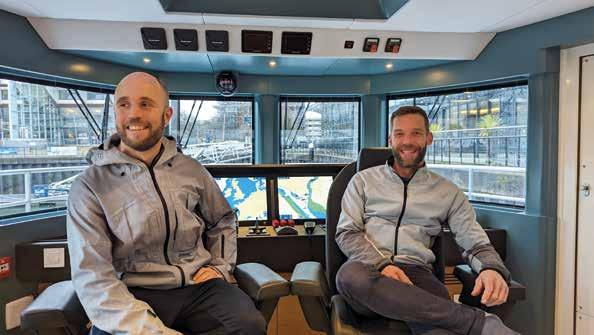
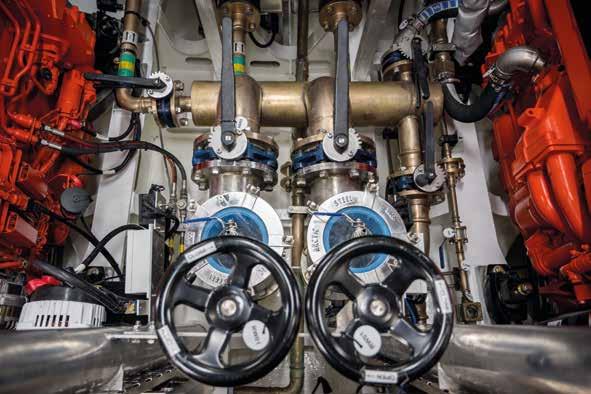
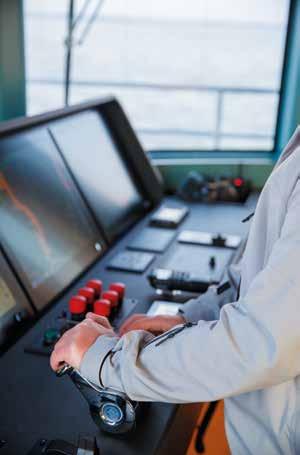


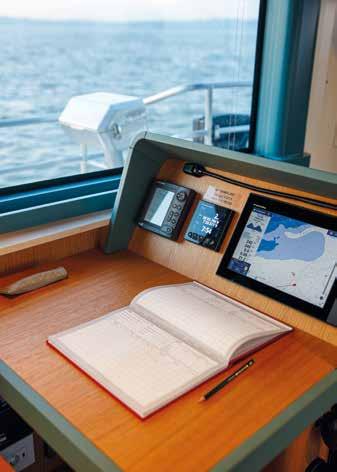
The additional strength of the hull is just one example of how the Arksen 85 goes above and beyond typical safety/damage requirements to ensure this vessel is capable of surviving a whole range of worst-case scenarios.
batteries, providing options from 22kWh to 66kWh usable capacity. The hybrid variant features 2 x 250kW electric motors, 3 x 250kW variable speed generators and 160kWh batteries, to provide maximum power efficiency, along with silent-running capabilities.
The other Arksen 85, due to launch soon, has the optional hybrid battery system, where the engines and generators are replaced with a hybrid dieselelectric system that provides around 24 hours of battery hotel-load operations as well as a 30-40mile cruising range. This can be further expanded by the solar panels on board the first Arksen 85, Project Ocean
Being able to run off the batteries and operate a sewage-treatment system on board allows for silent, emission-free operation. This capability grants access to environmentally sensitive and restricted areas such as the Norwegian fjords and remote islands where emissions regulations are stringent.
Internal space in this slim hull form has been maximised due to the clever design of on-board systems distributed around the vessel, behind removable access panels found throughout. On board Project Pelagos is an owner’s suite, captain’s cabin, two guest cabins and, at the bow, two bunk cabins that are outfitted to guest level but are also for crew or scientists. Other customisation options for this yacht include the addition of a utility room or a larger owner’s suite.
While its bare aluminium exterior clearly marks it out as an explorer yacht, the interior has been designed to be the exact opposite, fitted to a highquality spec to provide a comfortable and luxurious experience. This is also enhanced by the different layers of thermal and acoustic insulation that make the interior warm and quiet.
The glass has an XIR interlayer laminated into the glazing. This reflects infrared light which reduces additional heat entering the yacht. This XIR-laminated glass reduces solar-heat gain by an
average of 35 per cent more effectively than tinted glass. Reducing heating inside the yacht will in turn reduce the demands of the air-conditioning, further improving the efficiency of the on-board systems.
Arksen 85 has also been designed with consideration as to how scientific expeditions can be carried out on board – as part of the ethos of the company and to allow owners to facilitate scientific activities as encouraged by Arksen. Multipurpose spaces can be used as wet or dry lab spaces, and the structure of the aft deck, while designed to hold a 5.5-metre tender, is also strong enough to support a containerised lab.
The additional strength of the hull is just one example of how the Arksen 85 goes above and beyond typical safety/damage requirements to ensure this vessel is capable of surviving a whole range of worst-case scenarios, whether that’s an emergency steering system, corrosion-resistant copper-nickel piping and twin, double-capacity water inlets or additional scantling specifications more akin to a sturdy workboat.
Perhaps most noticeable is the increased number of watertight compartments. Mair explains, “We could flood any compartment, and we can still meet the stability criteria. A lot of people might assume that coming through this passageway and having a big watertight door may seem restrictive, but we actually find most people think it’s a really cool feature. It looks very in-keeping.” This aspect is something Arksen isn’t going to change, despite being asked previously, because safety is one of its core values.
The stability characteristics of the Arksen 85 are of a high level: it has 180-degree positive stability in all expected operation load conditions, which means it can right itself from being completely overturned. Alongside this, several on-board pieces of equipment are installed to reduce pitch and roll, assisting in making the Arksen 85 a stable and comfortable vessel.
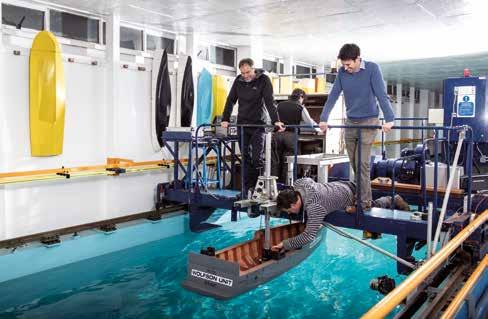
On board Project Pelagos are electric Humphree stabiliser fins, interceptors and two ‘flopper stoppers’ (as the team calls them) – metal plates that can be deployed from two booms on the aft deck to sit in the water. These passive roll stabilisers can achieve 60 per cent roll reduction with zero power needed to attain this once deployed. This type of stabiliser will also save on weight and hydraulics, as utilised in Project Ocean
Evidently, Project Ocean’s owner desired a much more stable on-board experience, and so the vessel has three types of stability measures on board: two different-sized Seakeeper gyros, a Humphree interceptor trim system and 1.3m² zero-speed fins. While this provides a much more comfortable experience on board in the rough seas explorer yachts tend to visit, it can also lead to propulsive power savings by being able to travel with optimal trim to reduce resistance. These varying stability offerings further show the customisability of this platform.
The efficient hull design necessitates a lower volume than that which might be seen on more conventional displacement vessels, which, along with the exceptionally high build quality, means that the pricing may be higher than some competitors, particularly when compared in terms of GT. The platform will, however, attract owners who appreciate and value the different aspects and capabilities of the design, meaning they can go on self-sufficient world cruises or access remote areas – or just have comfortable luxurious excursions.
Mair referenced an instance of the way in which Arksen are looking to better understand owners’ power consumption, to allow them to further tailor future vessels to a specific owner’s needs. During
the stay in Ocean Village, Project Pelagos’ owner has requested that the heating system be run at an economical level, to maintain a suitable ‘standby’ temperature whilst minimising power consumption. During this period, the Arksen team has been observing the power consumed in different scenarios, with and without the crew/guests on board, to further learn and understand the power demands. Arksen has found that minimum hotel loads are expected to be 2kW. At dock in the cold and wet UK weather, this has been about 5kW, and in hotter weather with guests on board and air conditioning running it’s expected to be closer to 15kW
Mair also explains the efforts made to run the generator as minimally as possible. If the generator is being used for one particular thing such as galley equipment, it will also run other power-hungry equipment such as the washing machine. Energy efficiency such as this will also save on fuel costs. However, Bowley says, “It’s not about the money. It’s about the fact [the owner] is a bit conscious of where it’s going … and doing just enough rather than being excessive.”
The energy efficiency of this design will be further enhanced aided in the next Arksen 85 to be built (Project Ocean) by the use of waste heat recovery. A heat reclamation system will use what would be waste heat from the engines and generators to preheat air that’s coming in from outside to reduce the load on the vessel heating system , and the heat expelled by the system is also reclaimed to begin the cycle again. This works the same in reverse in hotter climates, to reduce load on the air conditioning system.
Alongside this, another system uses the heated water, created as a by-product of the air-condition-
Even the aluminium is proving to be environmentally preferable, with 75 per cent of the aluminium produced still in use today, which was appealing to the owner of Project Pelagos.
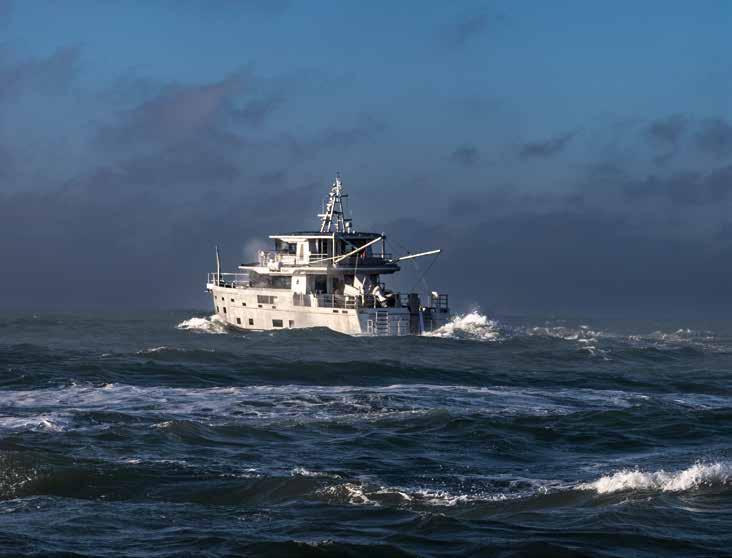
ing system, in the on-board white goods such as the dishwasher and washing machine. Using heatrecovery systems such as these will further contribute to reducing the energy demand required on the vessel.
Minimised fuel/energy consumption techniques are one of the many ways this vessel has – often as a side effect – improved sustainability aspects. For example, making the interiors removable for refit and servicing of the vessel not only saves on costs and time, it also means that new interiors don’t have to be remade, and so the impacts from the removal, disposal and replacement are eliminated.
Similarly, the high-quality materials and equipment used on board, in part to avoid breakage, are a further example of the priority put on the vessel’s autonomy, reducing the possibility of issues arising and also contributing to reducing any need for replacement or maintenance, which improves aspects of the yacht’s environmental impact.
Bowley says these choices go beyond just a greenwashing exercise, and that only genuinely better choices are used. For example, Arksen was looking to use recycled rope for these vessels but in talks with the supplier was told that it would get through recycled rope much quicker throughout the lifetime of the vessel. Therefore, actually investing in higher durability rope would be better, both financially and environmentally, which can then be recycled by that supplier at the end of its life, to be used in other products.
Even the aluminium is proving to be environmentally preferable, with 75 per cent of the aluminium produced still in use today, which was appealing to the owner of Project Pelagos. He asked Mair, “Does this mean that at the end my yacht could be made into another boat?” to which Mair responded, “Absolutely, and it means it could already have been a boat before too.” This further exemplifies the enthusiasm of all involved in these aspects of the build and cohesion with the philosophy of Arksen.
Njørdal, the type of aluminium used in this vessel, is another example of responsible sourcing to reduce the impact of the yacht in its early life-cycle stages. Njørdal is a low-carbon rolled aluminium produced by Speira, based in Norway. “Njørdal is a really exciting product for Arksen,” says Mair. “Not only does it have higher mechanical properties than many grades in marine aluminium, but it also has a higher recycled content, which is a really key thing for Arksen in our sustainability pathway.”
The recycled content is more than 70 per cent. Alongside this, Speira was involved in the early stages to advise on how to optimise the aluminium
construction and design in a recycling-friendly way for the end of life of the vessel. Besides the recyclability, the choice of this supplier enhances the improved sustainability because two-thirds of the energy supplied to produce this aluminium is from renewable energy sources, mainly hydroelectric.
After production, the aluminium is cut at Snijtech, in the Netherlands, which claims its 3,600 solar power panels generate more renewable energy than is used to cut aluminium, and so feeding renewable energy back into the national grid. Highquality materials such as this aluminium come at a cost, however, but Bowley argues the case of implementing them.
He explains, “There are other systems and pieces of equipment that could have been used that might have seemed more cost-effective. But actually, you look at it over their lifespan and you say, well, if you’re using the best quality materials and the best products, chances are it’s going to last significantly longer.” This means the investments in the initial build of this yacht will save on costs of any potential replacements in the future.
Those involved in the upstream stages of the aluminium also use renewable energy to power the processes required to manufacture the aluminium. While Mair agrees with the widespread view that there will never be a fully sustainable superyacht, Bowley points out, “People aren’t going to stop buying these boats. So actually, all of our responsibility is to try and educate and allow people to nudge the industry in the right direction.”
This has been done with the Arksen 85 vessels by ensuring the platform is adjusted to best suit the different operational profile characteristics of the owner and, within this process, Arksen ensures owners are making informed decisions with these choices. For example, in Project Pelagos, the owner’s suite could have been larger, but that would have led to a more cramped engine room. There could have been more stabilisation equipment, as in Project Ocean, but that would take up more internal space.
The Arksen 85 demonstrates what can be achieved after taking five years of extremely considered design process, prioritising efficiency, safety and impact reduction of an explorer yacht at every level. As Mair says, “everything is purposeful” on these yachts. Bowley concludes, “You can tell a lot about the quality of the vessel by what you find behind the scenes. The more you scratched the surface, you’re actually like, ‘Oh, it’s all clean and well-thoughtthrough shiny under there’. And she just gets cleaner and better the more you look.” MH
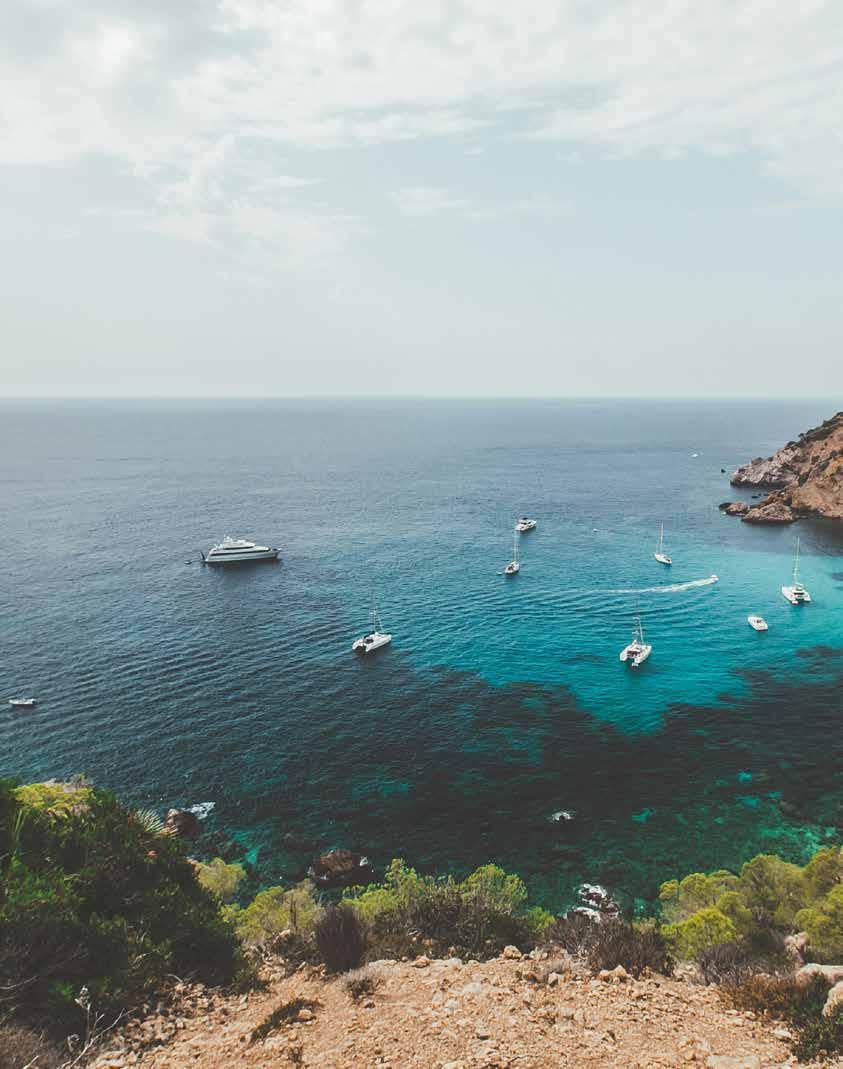


Today’s brokers have to do much more than just bring cash to the table and then sign off, with clients now considered to be long-term assets rather than merely a one-time source of income.
The superyacht industry has changed immensely over the past decade, and so have the processes that drive the brokerage sector. So, within this changing landscape, is the broker an indispensable valued advisor or do they just bring in the cash flow to the big brokerage houses and then let the specialists take over?
At The Superyacht Forum in Amsterdam last year, Camper & Nicholsons’ CEO Paolo Casani, head of new build Daniela Duck and head of yacht management Marianne Denissen led a discussion exploring the intricate role of brokers in the new-build sector.
As the oldest brokerage house globally, Camper & Nicholsons has adapted alongside each evolution of the industry, maintaining its relevance in the ever-changing landscape of new builds. Contrary to the common perception that brokers merely facilitate financial transactions, Casani, Duck and Danissen stress that the broker’s value transcends monetary aspects, encompassing an array of critical functions within the industry.
“In comparison with 10 or 15 years ago, the market was completely different. It was easier because it was almost enough to put together a buyer with a shipyard,” explains Casani. “Today, if you want to be a leading company, you have to justify your value with both the shipyards and the client.”
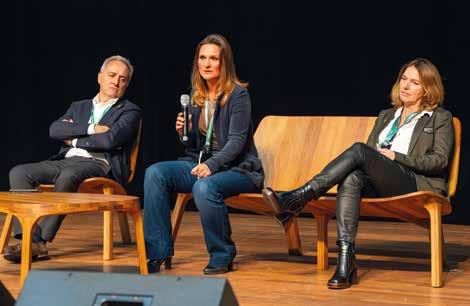
Ultimately, the most effective form of demonstrating your value to both clients and shipyards in the modern era comes through transparency, especially in the early stages of a purchase agreement. By managing client expectations from the start, negotiating realistic and mutually favourable contracts and ensuring brokers are educated on the latest processes and technologies, brokerage houses can ensure they not only successfully complete the initial transaction, but also establish a long-lasting bond with the client.
“There is less selling the dream and a lot more selling the reality,” says Danissen. “This makes the whole process a lot more enjoyable. Transparency has definitely increased from before, when you could sell a yacht to anybody on a more emotional basis. Yacht owners today are far more educated as well, and they want to be sure that they buy a good product.”
The Camper & Nicholsons panel at TSF 2023 (left to right): Paolo Casani, CEO; Daniela Duck, head of new build; and Marianne Denissen, head of yacht management.This clarity and reassurance are achieved through an amalgamation of processes that all begin at the initial point of purchase. Heightened awareness of all regulatory factors has become central to a broker’s role in the new-build process, particularly when it comes to regulatory matters and compliance with a shipyard’s client expectations.
Given the unexplored and potentially risky legal terrain arising from Russian sanctions and their impact on regulatory frameworks, discussions in the industry have consistently revolved around addressing the ensuing legal complexities. This heightened awareness has led to more rigorous implementations of Know Your Client (KYC) processes.
“Every day, we encounter new updates and developments in terms of KYC and compliance requirements. Banks are increasingly strict, demanding detailed documentation and KYC verification,” says Casani. “[Shipyards] expect us to precisely trace the source of wealth for clients. As an international company, we have to ensure our operations are well-structured to facilitate deals across various regions. This demands a high level of organisation and adaptability to comply with diverse regulatory environments.”
Within this dynamic, maintaining relationships is paramount to the value that brokers bring to clients, especially with shipyards. But once a brokerage then follows up the purchase through the role of a project manager, some might argue that there’s a conflict of interest, with the brokers having to maintain a healthy relationship with the shipyard while also acting in the best interests of the client.
However, Casani says, “There isn’t a conflict of interest because we don’t force anyone to purchase services from us. This is also why working with a single company rather than multiple can be advantageous, as it minimises other potential conflicts.
“Internally, our company entities have different legal structures. However, operationally, they collaborate to ensure the coordination of activities, always with the client’s best interests in mind. Our goal is to provide expert advice to clients, and while having good relations with shipyards can be beneficial, it’s not our primary focus.”
Brokers ultimately represent the
Marianne Denissen

“There is less selling the dream and a lot more selling the reality. This makes the whole process a lot more enjoyable.”
clients, not the builders, and this is why most brokerage houses are typically independent entities rather than being owned by shipyards and then having to toe the line of acting for both parties. Casani says their role is to assist clients in selecting the best shipyard based on their expectations, budget and delivery timelines, rather than favouring one particular shipyard.
That said, the brokers also have to provide a service to shipyards. When introducing a client to the builder, it must first ascertain that the clients are fully compliant with social and regulatory requirements. This mainly addresses the point that a client must be wealthy enough to afford the yacht, minimising the risk of the project falling into jeopardy because of a client’s economic downfall.
The upsurge in new-build sales over the past few years has also led to a significant increase in issues between clients and shipyards. Shipbuilders, having secured numerous contracts, often provide delivery estimates for projects with overly optimistic timelines. However, delays have become commonplace, causing frustration among
Paolo Casani

“It’s fundamental that the correct processes are considered in the initial phase of the contract with clearly stated clauses, penalties, grace periods, permissible delay – the goal is not to litigate.”
owners. Some projects are behind schedule for several months or even up to a year, intensifying tensions between clients and shipbuilders.
In moments such as these, it can be difficult for brokers to make the client understand that there’s a balance to strike. Clients are entitled to choose litigation, but they must be advised properly on what the ultimate benefit of that might be. By going down the road of litigation, owners can expect two or three years of tedious legal processes. If there’s more than a month of delay, and perhaps a subsequent loss of a season, this may not be ideal, but the end goal should always be ensuring that the client receives the quality of yacht that they expect.
“That’s why it’s fundamental that the correct processes are considered in the initial phase of the contract with clearly stated clauses, penalties, grace periods, permissible delay. The goal is not to litigate,” says Casani. “If delivery was supposed to be 20th December but it has become practically impossible, we would [already] know before the shipyard formally announces a delay because we follow the production daily and can
begin to plan renegotiations accordingly. So clearly stating these things in the contract beforehand will protect the client and the project in the long run.”
Clients may not be pleased by a delay, but if brokers make them see the practical side of the situation, there are advantages. If the brokerage team can use the delay as leverage in a renegotiation and agree on different penalties such as a longer warranty, this adds a lot of value to the yacht simply because it then obliges the yard to invest in the quality of the build. It’s also much better than the alternative, with litigation likely to push back a yacht’s delivery by several years as opposed to a few months.
And sometimes, when construction is delayed, fault isn’t always only on the shipyard; the client may also bear responsibility. Production schedules are often tight and delays from prolonged decision-making or lack of communication can have significant ripple effects, potentially impacting costs and timelines for ordering components or equipment. So it’s equally important for brokers to advise their clients to make key decisions in line with the shipyard’s schedule to prevent these situations from occurring further down the line.
The art of negotiation is central to a broker’s role, but when looking at the contracts themselves, there’s always room for improvement and further evolution to ease the processes, with potential lessons to be learned in the commercial sector. Considering this, could brokers add more value to clients and shipyards by creating a standardised contract for the superyacht industry, similar to commercial maritime contracts? This could prevent yards from initiating negotiation proceedings with a contract overly favourable to their own interests, which is commonplace at the beginning of negotiations.
For example, a 50-metre offshore support vessel and a Floating Production Storage and Offloading Unit (FPSO) may be valued at £60 million and £1.2 billion respectively, but essentially have the same contract; while the spec and the instalments will be different, the overall framework will be practically identical. However, this is why the transjurisdictional nature of the yachting industry complicates things, particularly when compared to the likes of the commercial sector.
“It’s our responsibility to educate and inform owners about the various possibilities available to them and the advantages that alternative solutions can provide, especially if they plan to enjoy their yachts for many years.”
There’s immense potential for synergies but, unfortunately, instead of addressing crucial matters, discussions often stray from the essential topics. This is a fundamental issue that deserves attention, but while striving towards greater unity for the collective benefit of all stakeholders could be a worthy endeavour, achieving global unanimity is an almost unachievable goal.
“Even though it might be a good idea, it’s hard to actually implement this on a large scale,” explains Duck. “It could be obviously an advantage. But again, usually, it’s the builder proposing the draft and it’s often tailored to the builder’s structure, experience and skills, also in terms of following up with the project.”
“It’s challenging because we operate in various jurisdictions, each with its own set of regulations and practices,” adds Casani. “Whether it’s dealing with Turkish shipyards, Italian shipyards or those outside of Europe, navigating these differences requires an intensive effort. Ideally, industry associations would play a pivotal role in the collaboration. This approach would benefit everyone involved – shipyards, brokers and, ulti-
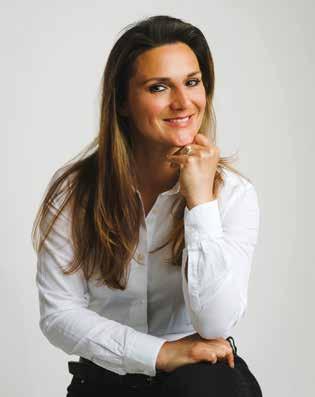
mately, our clients, who are the ultimate assets we are trying to protect.”
Although brokers have had to become more educated in the aforementioned legal, regulatory and contractual intricacies, being well-versed in emerging technologies has become paramount to the broker’s value in new build, particularly with the new emergent generation of first-time buyers. According to Duck, new owners tend to be more interested in the latest propulsion systems and on-board operations that will economise their yacht’s efficiency and protect it against changing regulations in the years to come.
“It’s also our responsibility to educate and inform owners about the various possibilities available to them and the advantages that alternative solutions can provide, especially if they plan to enjoy their yachts for many years,” says Duck. “The collaborative design phase involving the shipyard, designer and owner increasingly emphasises these aspects, ensuring owners are well-informed to make sustainable decisions and explore all possibilities for building a more environmentally conscious yacht.”
The modern era demands a focus on transparency to effectively demonstrate value to both clients and shipyards. This requires upfront management of client expectations, adept negotiation of contracts that serve the interests of all parties and ensuring that brokers stay abreast of the latest industry processes and technologies. This means brokerage houses not only ensure successful initial transactions, but also lay the groundwork for enduring client relationships. To truly add value in a new-build world, brokers have to be so much more than individuals who bring the cash to the table and sign off.
“Not everyone in the brokerage industry comprehends this yet, as the primary objective often appears to be selling a yacht,” concludes Casani. “Some may question why they should concern themselves with the buyer’s longterm interests once their commission is secured. However, this mindset is fundamentally flawed. In reality, it’s imperative to prioritise the client’s needs from the outset. The client is a long-term asset, not merely a one-time source of income.” CF

Introducing the IGY Trident Club, an exclusive members-only club meticulously crafted for discerning yacht owners.
Our club offers unparalleled experiences across an array of coveted yachting destinations, from berths in dynamic cities in the USA, to the turquoise waters of the Caribbean, the vibrant Latin American coastlines, and the enchanting European harbours, we invite you to roam freely within our elite community.
Anchored in excellence, the IGY Trident Club is your passport to a world of luxury, camaraderie, and unforgettable moments.
Enquire about IGY Trident Club Membership opportunities – Collective or Club tier. See our website for more details: igytrident.com

The REG Large Yacht Code forms the foundation of safe construction in the new-build sector. Here, we take a detailed look at how the 2024 revisions will affect the industry.
The Red Ensign Yacht Code was unveiled at The Superyacht Forum 2017 to consolidate expertise gained from the construction and operation of an increasingly diverse superyacht fleet. Twenty years after REG published the influential Code of Practice for the Safety of Large Commercial Sailing and Motor Vessels, or LY1, the REG Yacht Code responded to the evolving needs of the fleet.
The collective Flag registries that comprise REG set some of the principal regulatory underpinnings of new-build design and construction.
The pace of change within the sector has only increased since then, with designers and shipyards striving to meet the demanding expectations of discerning clients while also addressing the growing impact of restrictive regulations. The pivotal role of Flag and Class in ensuring the safe construction of the next-generation fleet has gained further significance as they adapt to this rapidly changing market.
The comprehensive overhaul of the yacht code resulted from a two-year collaboration, marked by multiple industry consultations. These included wellsupported working group meetings held across Europe and the UK between 2022 and 2023. The process involved active participation from a wide array of stakeholders, totalling 153 entities spanning REG administrations, classification societies and representatives from industry associations, naval architects, management companies and shipyards.
According to the Red Ensign Group, this effort aimed to underscore a commitment to inclusivity, ensuring that every sector of the industry not only provided input but also played a pivotal role in shaping the code. Among the main architects of the updated code were Andy Hinshaw from the UK Ship Registry, Carlo Vinelli, senior surveyor at the Isle of Man Ship Registry, and Julian Smith, principal surveyor and current REG Yacht Code Secretariat from the Cayman Islands Shipping Registry.
“Sometimes the brief and requirements from a designer clash with the technical regulations,” says Hinshaw. “This necessitates a reactive code and one that needs to be updated in response but which stays in keeping with our fundamental commitment to safety.”
“We have several driving factors
necessitating amendments to the code,” says Smith. “These include emerging regulations published by the IMO affecting various technical requirements, changes in current thinking and trends in terms of design and construction of large yachts, and areas in the code that previously did not fully address technical issues affecting safety and pollution prevention.”
“The number of yachts subject to novel design approvals is growing every year,” says Vinelli. “If we look back 15 years, for example, yachts were quite standard comparatively.” Today’s new builds not only incorporate new technologies, but also adopt a new aesthetic, often necessitating a reassessment of safety standards and the application of the yacht code.
Increased emphasis on alternative fuels is a reaction to a small but growing demand from certain projects. Vinelli explains, “We have seen an increase in inquiries about the uptake of alternative fuels like methanol and hydrogen in new builds. The challenge of educating owners about the benefits and feasibility of adopting these technologies is still an issue, but we are working to ensure the code can help with the transition.
“Technical consistency is something we take very seriously. We recognise the importance of ensuring that we provide a level playing field to the industry and avoid inadvertently placing one shipyard at a commercial disadvantage due to slight variations in how the code is applied.”
Alongside broader refinements of the code, the 2024 update has addressed some highly specific and yacht-centric issues. A less obvious example of this regulatory adjustment is that of navigational bridge visibility, particularly for yachts under 55 metres. Unique and unconventional designs that alter the bridge position in a way that may restrict the viability of the helm station leave some yachts exposed to the generic satisfaction of the appointed surveyor, which may lead to very different interpretations. “This was not such an issue in the past, but we have had to adapt the regulations to bridge the gap for smaller yachts,” says Vinelli.
The increasing numbers of support yachts in the fleet and under construction have been some of the most conspicuous
Increased emphasis on alternative fuels and energy efficiency
The code has introduced provisions to support the adoption of alternative fuels, addressing the maritime industry’s shift towards more sustainable and environmentally friendly practices.
Fire-safety enhancements
There’s a greater focus on improving firesafety measures for yachts under 500gt and for those yachts carrying electrically driven tenders and toys. The updates include more detailed requirements for structural fire protection, fire detection and firefighting equipment, aiming to mitigate the risk of fire incidents on board.
Structural and stability requirements
The code has introduced updated design criteria for hull shell doors and their hydraulic control systems. Additional stability requirements have also been added for those yachts incorporating tender garages and beach clubs with low sill heights, assuming such spaces are partially flooded.
Life-saving appliances and arrangements
Additional prescriptive requirements for life-saving appliances and arrangements have been added and are aimed at ensuring a more technically consistent application of the code.
Technological innovations and flexibility
Recognising the rapid advancement in maritime technologies, the code now provides a framework for the integration of new technologies into yacht design and operation.
additions. According to Smith, these distinctive vessels have also presented a challenge to regulators. “These so-called shadow vessels have previously fallen into a grey area,” he says. “There has been some ambiguity as to whether these are merchant ships and what the requirements would be to qualify for a certificate under the yacht code.”
These vessels present a complex combination of features for regulators. They typically carry a wide range of highrisk items, various tenders with different fuels, multiple helidecks and hangars, as well as sophisticated diving equipment. Smith says, “We have provided some clear guidance under the code via simple definitions as to what qualifies as a support vessel and what they can carry on board.
“A good example regarding the scope of the code having been expanded is with respect to diving operations. We now have prescriptive requirements for both air and nitrox as well as hyperbaric decompression chambers. We have always had requirements for submersible craft, but underwater exploration is an area where we continue to see growing interest, so we have expanded the scope to ensure that such high-risk activities are properly addressed.”
The ‘short-range yacht’ option within the REG Yacht Code refers to provisions that allow yachts that do not comply with the requirements for unrestricted service
The average LOA for the overall fleet is 41.4m
Category 1 is made up of Bermuda, British Virgin Islands, Cayman Islands, Gibraltar,
to operate within specified geographical limits and weather restrictions subject to compliance with reduced criteria. In maritime regulations, ‘short-range’ operations often have implications for the design and safety equipment on board, acknowledging that yachts staying closer to shore or operating within certain areas aren’t expected to face all of the same risks as those navigating across open oceans.
“Based on feedback received from a wide-ranging number of industry stakeholders, we have extended the availability of the Short Range Yacht option from 300gt to 499gt subject to the provision of additional fire-safety measures, which I am confident will be well received,” says Smith.
The recent spate of fires on yachts, particularly those under 500gt with composite builds, has cast a spotlight on industry safety standards. Recognising the need for informed regulations, key industry players have leveraged underwriter data to guide their decisions, ensuring that any new measures consider their commercial viability. It’s a delicate balance between the technical and commercial impact, ensuring that an appropriate level of safety is implemented and maintained.
“It's fair to say that the wider yacht industry has had a lot of bad publicity recently due to a number of factors, including the number of yacht fires,”
says Smith. “While the reasons behind these fires are many, it was clear that we needed to react as Flag States.”
A pivotal change in the updated yacht code is the adjustment of compliance timelines, now pegged to the contractsigning date rather than the keel-laying date. This shift aims to grant shipyards a longer runway to ready themselves for new regulatory demands. This proactive measure ensures that the adaptation to updated standards begins earlier in the vessel’s construction journey.
However, to accommodate speculative builds – those initiated without a contract – the keel-laying date remains the reference for compliance. This nuanced approach balances the need for timely preparation with the diverse construction practices of shipyards.
The push for faster and smoother compliance processes is essential as yacht builders push the boundaries of modern yacht design. Of particular significance for regulators is the growing trend of expansive yacht glazing. This design choice, driven by the desire for greater visual connectivity with the ocean, presents complex challenges from structural and fire-safety perspectives.
“During a recent engagement with the ISO 11336 working group in Germany, the topic of glazing was a focal point, underscoring the need for new standards that can accommodate the increasing size and scale of glass features on yachts,”
says Smith. “The trend towards more glass not only enhances aesthetic appeal, but also introduces complications that span thermal efficiency, structural design and fire safety, making the development of suitable glazing standards a critical area of focus.
“In the latest yacht code revision, the regulatory team has been particularly diligent in avoiding the introduction of rules that would apply retrospectively.” One clarifies that only a single retrospective requirement has been introduced, which concerns passenger yachts and involves the provision of a loading and stability instrument. This instrument is, however, already regarded as fairly standard on existing passenger yachts, so the impact is expected to be negligible.
“This code update aims to avoid the complications seen in the 2019 code update, which introduced several retrospective requirements that affected the industry,” explains Smith. “We believe that this foresight will ensure that the new regulations are forward-looking without disadvantaging the existing fleet.”
Looking further ahead to the next iterations of the code, REG sees a number of key areas that will likely be under additional focus in future. With several large-scale sailing-yacht projects currently underway, the technical demands of operating such vessels are significantly amplified for the smaller yachts. “The complexity of rigging on super-sized sailing yachts, particularly those exceeding the 100-metre mark, has become a focal point for the industry and an area of focus for us as Flag States,” says Smith.
The maritime industry’s pivot towards greener propulsion technologies mostly focuses on the bridging solution of diesel-electric systems complemented by substantial lithium-ion battery reserves. However, these steps, while progressive, still rely on traditional diesel fuel and do not fully resolve the issue. A more complete solution will need a rethink in the transition to methanol and other alternative fuels face significant
The updated code reflects the delicate balance between tradition and progress – a testament to the industry’s ability to adapt, innovate and anticipate challenges on the horizon.
hurdles, particularly in overcoming the energy density dilemma that these fuels present.
“The crux of the matter also involves educating yacht owners about operational expectations and refuelling logistics,” concludes Smith. “An integral part of this shift will be the development of a robust infrastructure to support new fuel types, a classic ‘chicken and egg’ scenario whereby the provision of facilities and the adoption of the technology are interdependent.”
The impact of these revisions extends far beyond compliance checkboxes and regulatory mandates. As the nextgeneration fleet evolves, so too, says REG, will the Large Yacht Code, and the 2024 revisions are illustrative of the ongoing evolution of safety and environmental standards within the new-build sector. Beyond the technical adjustments and regulatory tweaks, these revisions show a collective commitment to navigating the complexities of an ever-evolving legislative landscape.
At its core, the updated code reflects the delicate balance between tradition and progress – a testament to the ind-
ustry’s ability to adapt, innovate and anticipate challenges on the horizon. Through collaborative efforts and forward-thinking initiatives, stakeholders have come together to shape this framework that not only meets regulatory requirements, but also embraces the spirit of responsible stewardship of the industry, serving as a clarion call for continued collaboration and dialogue across the superyacht community.
This collaboration will be paramount over the next few years, with further opportunities for code refinement, particularly with sailing-yacht rigging complexity and the transition to greener propulsion technologies already in the regulators’ crosshairs.
Education and infrastructure development will be crucial in facilitating this transition, ensuring that owners and builders are equipped to embrace new operational expectations in order for yachts to maintain their value and remain in compliance with changes that are yet to come.
The full version of the code is available now from the REG website and comes into force in July 2024. JH
All analysis was undertaken by our data and research consultants. We provide bespoke consultancy projects that help clients make informed, data-driven decisions. Scan the QR Code to see examples of our work.
 BY DARIO SHIAVO
BY DARIO SHIAVO
 Interview with Baglietto CEO Diego Michele Deprati
Interview with Baglietto CEO Diego Michele Deprati
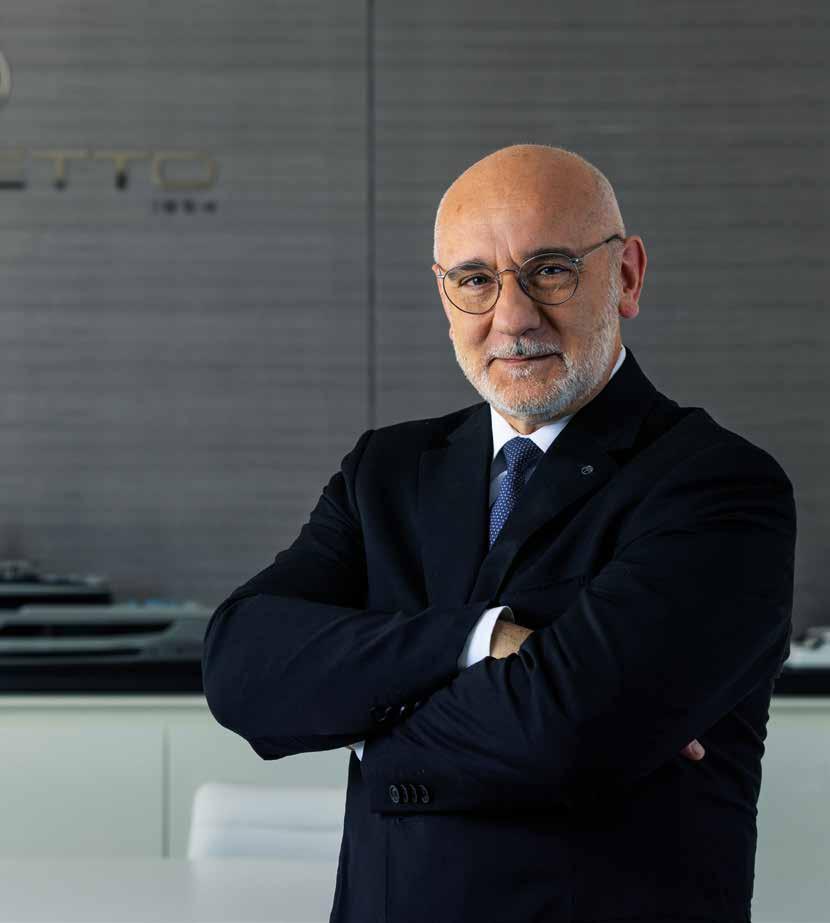
This year marks the 170th anniversary of the Baglietto brand, and with the introduction of the new XO line of explorer yachts, the shipyard is venturing into new territory. Here, Dario Schiavo speaks with CEO Diego Michele Deprati about the yard’s latest product lines, its investment in infrastructure and his views on how the market will respond given current world geopolitics.
As Baglietto commemorates its 170th anniversary, it also celebrates the launch of two new 50-metre projects designed by Francesco Paszkowski – the FAST50 and the X50 explorer yacht. The company is in a strong position to respond to changing trends in a dynamic and competitive market, having recorded results that show a 37 per cent growth in sales in 2023, with a 20 per cent gross operating margin and a €500million order book.
This strength lies in a shipyard that is dedicated to blending innovation with tradition – as well as CEO Diego Michele Deprati’s 34 years of experience. Deprati trained at the Italian Naval Academy in Livorno and, after initial experience as a naval officer, ventured into the nautical world at the Mondomarine shipyard, where he devoted himself to the construction of small fibreglass boats. This proved to be pivotal for his professional development, and he considers his time at Mondomarine as an essential part of his journey.
In 2012, Deprati joined Baglietto, a shipyard that resonated with him deeply due to his origins in Savona. There’s a profound romantic aspect to Deprati’s career and dedication, as he had envisaged working at Baglietto since childhood, viewing it as his dream location.
Baglietto is one of Italy’s oldest shipyards, founded in 1854 by Pietro Baglietto with the purpose of building ‘gozzi’ (local boats) and small hulls. In 2012, the Gavio Group acquired Baglietto, writing a new chapter in its history.
Following the initial years of start-up and the shifts brought about by the pandemic, Deprati was entrusted with the task of integrating the Gavio family’s two nautical brands – Baglietto and CCN –and steering the company towards new horizons.
Today, Cantiere Baglietto specialises in the construction of aluminium planing yachts ranging from
38 to 50 metres, as well as displacement and semidisplacement superyachts starting at 35 metres, crafted from steel and aluminium. The business operates across two locations: La Spezia, which serves as the headquarters, and Carrara.
The La Spezia site spans approximately 35,000 square metres and has recently undergone a transformation. Over the past three years, three new sheds have been constructed to accommodate vessels up to 65 metres. Additionally, equipped docks capable of hosting vessels up to 70 metres have been established.
In Carrara, the operational hub comprises two 5,000-square-metre areas. One is designated for the construction of military boats under the Baglietto Navy brand, while the other is reserved for building yachts up to 50 metres across four warehouses.
Deprati confirms that the current stability in market demand drives the shipyard to major investment and its belief in continued innovation. “What reassures us is that despite the international scenario and the turbulent period we are experiencing, which inevitably affects this sector as well, we can still count on a positive trend that has been accompanying us for about three years.”
As Deprati highlights, the demand for luxury yachts remains robust, propelling Baglietto to secure multiple contracts for vessels ranging from 40 to 52 metres. Since 2020, Baglietto has demonstrated impressive sales performance, with a total of 30 yachts sold. Among these, the Dom 40 and T52 models have emerged as clear favourites, accounting for 10 and nine units respectively sold over the past three years.
This success has translated into a substantial order book, estimated to be worth around €500 million. “With such strong market performance, there are currently no signs of a slowdown on the horizon for Baglietto,” says Deprati.

He explains how, compared to a few years ago, the concentration of wealth at the global level has shifted, and this offers the yachting industry greater stability. Today, purchase requests are coming from countries that, until about 20 years ago, did not appear as players in the world market scenario, such as China, India and South Asia.
“Today, we have also expanded to Australia, where we have service points, and we have representatives in Singapore,” says Deprati. “We are also investing in the search for suitable individuals who have the right standing to represent our products, which traditionally embody excellence and highend quality. This effort aims to consolidate and expand our presence globally.”
Despite such positive news, one might wonder if this trend will last or if it’s just another bubble that the boating industry has become accustomed to over the years. However, according to Deprati, any slowdowns or brakes will affect only the under-30metre sector, due to both the geopolitical context and cyclic market saturations.
None of this will influence Baglietto’s production, which is geographically divided; 40 to 50 per cent of production is destined for the Americas, 20 to 30 per cent for the European market and the rest of the world, with only a very small portion remaining in Italy.
In relation to the market in the United States, Deprati refutes reports of slowdowns in demand. “Even in their segment, the US market is still very robust in demand and, in fact, demand is increasing almost against the trend,” he says. This is probably due to the Italian character of the brand which has never strayed from its identity as a boutique shipyard and aims to maintain these standards in the future.
Deprati adds, “We owe gratitude to Beniamino Gavio, who has led the group since 2009 and
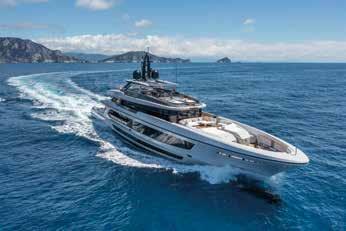 Two of Baglietto’s four product lines: DOM 115 (above), designed by Stefano Vafiadis, and T52 (below), designed by Francesco Paszkowski.
Two of Baglietto’s four product lines: DOM 115 (above), designed by Stefano Vafiadis, and T52 (below), designed by Francesco Paszkowski.
consistently demonstrated his commitment to revitalising the brand’s value worldwide. We communicate daily, sharing decisions and the company’s direction.
“He prioritises production, evident in his support for reinvesting profits in new infrastructure and cutting-edge technologies. He is a patron with whom it is truly a pleasure to work, showing genuine care for the brand which, according to him and the company’s philosophy, belongs not only to the group but to the entire country.
“Therefore, it is a moral commitment to reaffirm our Italian character to our customers every day, in a world heavily influenced by foreign capital, where the risk of losing traditions is significant.”
The shipyard attributes its success to priding itself on having a passion for yachting as its sole driving force. As an example of this, Deprati says that in his 34 years of experience, he has never missed a sea trial.
“I consider every boat to be my creation,” he explains. “When I board it, I perceive from how I feel, from how I live it, from how it sails if everything is okay. And I can do that from the very first test. If I don’t establish a connection with the boat, if I board it and don’t feel it’s mine, I don’t approve the delivery. And that’s the way we think about and experience the yard.”
Baglietto offers four product lines: the displace-
Baglietto encapsulates the quintessential traits of an authentic Italian shipyard, featuring products crafted by Italian designers, overseen by Italian management and owned by Italians.

ment line, the Dom displacement line designed by Stefano Vafiadis, the Tline displacement line and the FAST semi-displacement line, both designed by Francesco Paszkowski. Additionally, there is the custom line, which Baglietto has historically produced to enable customers a flexible build, albeit on established engineering ship platforms.
Among recent boats, the motoryacht Francesca II in the FAST line was delivered last year. This 41-metre vessel was designed for a client who already owned a Baglietto yacht and had developed a fondness for that model. Together, they explored the design he wished to adapt, meeting all contractual requirements.
“Our advantage lies in ensuring the speedy realisation of designs and guaranteeing high performance without compromising extreme comfort,” says Deprati. “These are qualities we also ensure in the 50-metre FAST, a fast displacement vessel with four engines, spanning three decks, offering exceptional comfort and capable of reaching speeds of up to 30 knots.”
At Carrara, Baglietto is dedicated to building military boats. “It all began five years ago when we were summoned by the Chief of Staff, who tasked us with designing a particular boat that had never been produced in Italy,” says Deprati. “We even developed a prototype that led to a navy order through Fincantieri. We constructed two 15-metre
combat boats intended to accompany the navy’s flagship.”
These vessels, capable of reaching approximately 45 knots, boast very high technological content and are utilised for landing navy infantrymen in operational scenarios.
“We have engineered this product, and on the same platforms we are also designing vehicles intended for patrol vessels and ambulances,” says Deprati. “We are specialising in this segment, and to do so to the best of our ability we have decided to dedicate a business unit to it. In a world such as yachting which, although now reassuring us with comforting certainties is by its very nature undulating, we believe that defence equipment can form the solid core of our production.”
Until 2023, military sales had little impact, accounting for only 5 to 10 per cent of orders. “However, we are certain that in 2024-2025, the numbers are bound to increase, partly due to business associations made with other companies and additional orders,” says Deprati. “The navy highly appreciated the first boats we made, which serves as an important motivational boost for us.”
In relation to refit, however, a sector of the boating industry that many shipyards are focusing on, Baglietto is experiencing significant infrastructure constraints, and refit services, at least for the moment, are limited to Baglietto customers.
 Below: XO concept –part of a new explorer segment designed for extended oceanic voyages worldwide.
Below: XO concept –part of a new explorer segment designed for extended oceanic voyages worldwide.
FAST50 (rendering), designed by Francesco Paszkowski Design, will be able to reach a top speed of 30 knots.
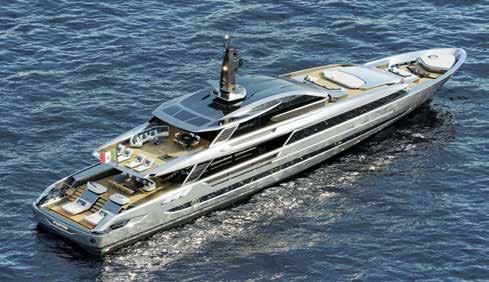
Regarding Baglietto’s stance on future technologies, Deprati says, “We are in a time of transition, and today it is difficult to predict what the technology of the future will be. However, I can certainly say that hydrogen will be of great interest. We have developed a demonstrator ashore with a component that can be installed aboard 50- and 60-metre yachts.
“This system takes seawater, demineralises it, purifies it and, using energy from solar panels in the sheds, separates hydrogen from oxygen. The stored hydrogen is then used in the fuel service to generate electricity. We will be ready to install this system on board as a supplement to the on-board hybrid components initially for on-board hotel services. However, we are confident that the system can have wider applications and become increasingly highperforming.”
There is great excitement at Baglietto today for the launch of the Paszkowski signature projects, the FAST50 and the Explorer XO. The new 50-metre project FAST50 represents the top of the range in the line of fast, innovative and technological yachts that have always represented the La Spezia brand, while the XO concept is part of a new explorer segment designed for extended oceanic voyages worldwide, whose first design will be X50.
Duprati says XO is not just an explorer but is, above all, a new way of living and experiencing the sea. ‘Explore, Experience, Observe’ is the origin of the name of the XO line because as well as the possibility of great sailing, there’s also the ability to perceive it through an innovative vantage point.
The yard says this innovation lies in the observation area above the wheelhouse, which offers a different kind of space from which to enjoy
a panoramic view of the surroundings. With such a project inherently designed for long voyages, the observatory serves as an entertainment space essential for extended crossings. The vessel is fitted with large flush windows to enable 360-degree views, while the central skylight allows passengers to relax under the night sky.
Baglietto emphasises that despite expectations that this yacht might depart from the flowing and essential lines typical of Baglietto yachts designed by Paszkowski, it actually retains many stylistic features of the brand’s tradition, maintaining the aesthetic characteristics of a ‘working’ boat typical of an explorer while preserving its unique style.
The FAST50, on the other hand, is a 50-metre vessel equipped with four MTU 2000M96L engines and capable of reaching a top speed of 30 knots. It features a light alloy fast-displacement hull and serves as the flagship vessel of Baglietto’s FAST line, also designed by Paszkowski. This model confirms the shipyard’s leadership in the segment of large, highly customised aluminium fast boats.
Baglietto encapsulates the quintessential traits of an authentic Italian shipyard, featuring products crafted by Italian designers, overseen by Italian management and owned by Italians who adamantly oppose listing the shipyard on the stock exchange or selling any portion to investment funds.
It is building on the solid foundations that the market is currently enjoying, while acknowledging a perceptible slowdown given various global geopolitical scenarios. However, the yard’s adaptive strategies indicate a resilience underpinning the industry as a whole as it looks to successfully navigate future trends and developments. DS

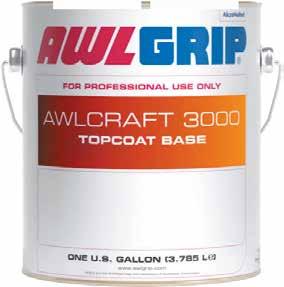
Everything you love about Awlcraft 2000, including tried and trusted application characteristics and repairability, but now enhanced with our next generation color platform. Awlcraft 3000 gives you deeper, more vibrant colors and a long lasting, high gloss finish to turn heads.


Here, we analyse the latest developments, trends and forecasts in deliveries, engine manufacturers and the GT effect, as well as detailing the increasing influence and future growth prospects of SYBAss in the new-build sector.
TEXT BY JACK HOGAN DATA BY THE SUPERYACHT AGENCY INTELLIGENCE TEAMThe 30-metre-plus superyacht fleet witnessed significant growth in 2023. After a relatively stagnant period from 2014, where the average yearly output was just under 160 units per year, deliveries spiked back up to 211 in 2023.
Of particular note was the high number of 90-metre-plus deliveries in 2023, with a total of seven for the year. Lürssen showed particular dominance in this space with the launch of the 146-metre Opera and the 90-metre Norn. Oceanco also continued its run of sizable and high-profile yachts with the 109-metre Seven Seas and the 127-metre sailing yacht Koru joining the fleet.
90 - METRE - PLUS DELIVERIES IN 2023
60 - 90 - METRE DELIVERIES IN 2023 Source
The 60-90-metre sector also saw an increase in numbers, with 18 yachts delivered. Honours here were relatively shared across the major yards. Damen Yachting saw the most representation with three deliveries averaging 65 metres and 1,196gt. Feadship’s typically prominent representation in this sector saw the iconic Obsidian at 84 metres and the 67-metre Sibelle join the fleet.
Forecasting future output across the yards has been difficult, with these stable years dictating that all predictive models produce a stable, if unremarkable, output. With this growth factored in, the statistical models present a more optimistic picture for future deliveries.
In 2000, 40-60m superyachts accounted for 19 per cent of annual deliveries. By the end of 2023, with the build size of superyachts noticeably increasing, the 40-60m sector accounted for 27 per
The Superyacht Builders Association (SYBAss), established in 2007, has become an influential organisation within the superyacht industry. The Association is open to yacht builders that have been operational for at least 10 years and have delivered either a minimum of three motoryachts over 40 metres or three sailing yachts over 30 metres in length. These stringent membership criteria ensure that SYBAss represent the most experienced and reputable shipyards in the industry. But how have its members performed as a subsect of the overall fleet?
SYBAss’ market influence in 2023
In 2023, SYBAss members delivered 44 per cent of all 30-metre-plus superyachts and accounted for half of the total length overall (LOA) produced globally. Furthermore, these shipyards produced 65 per cent of the total gross tonnage (gt), showcasing their role in delivering larger and more complex vessels.
SYBAss members’ 40-metre-plus yacht sector highlights the dominance of the group, which consistently delivers a larger share of the fleet (except in 2016). Forecast models reveal different growth scenarios, considering the capacity of the global shipyard network, suggesting healthy growth from member shipyards.
The examination of individual member yards since 2015 (overleaf) illustrates their strategic contributions to the fleet and highlights a robust order book for future deliveries. AddWitionally, the potential for SYBAss’s growth is notable, with several shipyards meeting membership criteria but not yet part of the association, suggesting room for expansion and potentially strengthening SYBAss’s influence in the superyacht industry.
SYBAss and its members play a crucial role in the superyacht industry, not only through their substantial contributions to the market’s output, but also in driving innovation and quality standards. This analysis underscores the association’s potential for further growth and its lasting impact on the development of the superyacht sector.
• The Superyacht Builders Association (SYBAss) is a membership organisation, founded in 2007, open to yacht builders that have been in existence for a minimum of 10 years and delivered at least three motoryachts measuring more than 40 metres or three sailing yachts of at least 30 metres.
• As displayed in the below graphics, SYBAss members delivered 44 per cent of 2023 superyachts and delivered half of the total LOA(m) produced by the global shipyards.
• A significant contribution of SYBAss members came in the form of gross tonnage, where member shipyards produced 65 per cent of the total gross tonnage delivered in 2023.
Contribution of SYBAss members, potential qualifier members and non-member qualifiers to the 40-metre-plus fleet
SYBASs members’ total deliveries since 2015 and the order book
In 2023, SYBAss members delivered 44 per cent of all 30-metre-plus superyachts and accounted for half of the total length overall produced globally.
Gross tonnage (gt) is arguably the most misunderstood but commonly used term in the yachting industry. The definition bears repetition. Gross tonnage is a measurement used in the maritime industry to indicate the overall internal volume of a ship. It’s a standardised measure that includes the entire enclosed space within a vessel, including cargo holds, engine rooms, crew quarters and any other enclosed spaces.
Gross tonnage is calculated in accordance with international regulations set by the International Maritime Organ-ization (IMO). The formula for calculating gross tonnage considers the volume of the ship’s enclosed spaces and is used for various purposes, including determining registration fees, port dues and safety regulations.
It’s important to note that gross tonnage is distinct from a ship’s displacement, which refers to the weight of water displaced by the ship’s hull and is a measure of the ship’s actual physical size and buoyancy in water.
While not directly representative of the ship’s mass, it does give a great yardstick as to design trends and the amount of usable space for an owner, and crucially, yachts above a certain gross tonnage threshold may be subject to stricter regulatory requirements for commercial operation.
To encompass the important 500gt and 3,000gt thresholds, this analysis uses slightly different size brackets, 4560 metres to capture the 500gt mark and 80-100 metres to capture the 3,000gt.
There is an inbuilt flexibility in these Gross tonnage calculations, with some designers and shipyards using the full range of the regulations to keep a vessel below a certain regulatory threshold. When the fleet’s gross tonnage is plotted on a scatter plot, it’s fairly obvious where these demarcations occur. This is starkest in the 45-60-metre-plus sector. The logjam of vessels at 499gt is clear to see.
Understandably, there are very few yachts between 500gt and 600gt. A sim-plistic way to view this is that in the design process, if a yacht is going
to be over that threshold, it may as well maximise its volume and usable space.
Even segmented into a narrow bracket of 45-60m, the variance in gross tonnage is drastic. Outliers of note here, and to give context, the lowest gross tonnage motoryacht is the 2001 Turquoise Yachts Arriva at 48 metres and 229gt. The most voluminous launched yacht in this size bracket is the 2008 Lürssen Vive la Vie, at 59m and 1,277gt. This will be surpassed in 2024 by a 58-metre RMX Marine project that comes in at a colossal 1,365gt.
The 80-100m scatter plot displays the same trend around the 3,000gt mark, although less pronounced due to the lower number of yachts in this fleet. The grouping of yachts at 2,999gt is obvious, and the variance in gross tonnage is equally large. The outliers of note here are the Corsair Yachts’ modern classic Nero at 90 metres and 1,413gt and the 2019 Silver Yachts’ Bold at 85metres and 1,504gt at the other end of the scale.
Outside these ranges, there are some other noticeable trends in the percentage shifts in gross tonnage since 2000. The
Superyacht Agency developed a different model for analysing this shift. The gross tonnage percentage graph outlined compares the historic fleet (2000-2020) with the past four years (2021-2024) and order book. For the purposes of this analysis, the fleet has been broken down into smaller 5-metre segments.
The percentage shift seen in the graphic below shows the significant increase in gross tonnage for smaller yachts between 2021-2024 (plus orderbook) in comparison to 2000-2020, most drastically in the 30-35-metre bracket (13.7 per cent) and the 35-40-metre bracket (10.8 per cent), suggesting a trend towards more volume from these smaller yachts.
There is a notable decline in gross tonnage for vessels ranging between 50 -55 metres (12.5 per cent), 80-85 (7.9 per cent) and 85-90 metres (14.3 per cent). These declines correspond closely to the scatter plots of gross tonnage vs LOA and the concentration of yachts that are engineered to keep their gross tonnage below the 500gt and 3,000gt regulatory thresholds respectively.


SHOULD WE REBRAND?
WHICH REGION ARE WE BEST KNOWN?
per year.Incent,as delaysdue relatedtoCOVID-19.Asimilarlevelling numbersisexpectedin2022,resultingin evenspreadofdeliveriesandtherefore valueacrossthenextfewyears. Italianbuiltyachtsaccountedfor33percentofthe marketvaluein2021,andatpresent,accountfor39 percentoftheorderbookvalue.Yachtsconstructed intheNetherlandsaccountedfor31percentofthe marketvaluein2021,andatpresentaccountfor 25.4percentoftheorderbook.
WHO IS OUR IDEAL CUSTOMER?
HOW DO WE COMPARE TO OUR COMPETITORS?
WHAT DO STAKEHOLDERS THINK OF US?
ARE WE TARGETING THE RIGHT PEOPLE?
WHAT DOES THE MARKET THINK OF US?
WHAT MARKETS ARE A PRIORITY FOR GROWING OUR BRAND?
Great decisions don’t start with assumptions. Let us provide the answers.
Using bespoke quantitative surveys and qualitative interviews, our data and research consultants provide real insights and analysis around the market's perception of brands and businesses. Scan the QR Code to see our work.
Percentage market share of the top five engine manufacturers, 2000-2023
26.8m €32.3m €10.0m €25.4m €4.1m
€12.3m €24.0m €8.3m
€3.1m €12.5m
€169.4m
€4.3m
€55.1m €131.2m €131.2m
€28.0m
€123.1m
*CurrentrecordedglobalOrderBookfiguresfor40m+yachtsattimeofreport’s publication.†ForecastednumberscalculatedusingexistingOrderBookfigures,thatanaverage ofbetween20and30percentoftheOrderBookwilllapseintothefollowingyear. 2024 2025 €50.4m €25.4m
}
The top five engine manufacturers collectively accounted for 95 per cent of the market share
This study examines the distribution of market share among engine manufacturers for superyachts delivered between 2000 and 2023, identifying the top five manufacturers and analysing their market share dynamics over time. The research highlights significant trends and shifts in the industry, with a particular focus on the rise of MAN and the sustained dominance of MTU and Caterpillar.
In the evolving landscape of the superyacht industry, engine manufacturers play a pivotal role in determining the performance, efficiency and environmental impact of these luxurious vessels. This study aims to uncover the market share distribution among these manufacturers, identifying key players and trends over a 23-year period.
The analysis was conducted on a sample of 4,111 delivered vessels (96.7 per cent of the market), focusing exclusively on those powered by a single engine manufacturer to maintain clarity in market share attribution. The study calculates the total number of vessels supplied by each manufacturer, and uses this data to determine their respective market shares.
Our findings reveal a market primarily dominated by two manufacturers: MTU (54 per cent) and Caterpillar (30 per cent), with MAN (7 per cent), Cummins (3 per cent) and Volvo (1.4 per cent) completing the top five. Together, these manufacturers account for 95.4 per cent of the market, leaving a minimal share to others. Notably, MAN has shown remarkable growth, particularly from
The market is primarily dominated by two manufacturers: MTU (54 per cent) and Caterpillar (30 per cent).


2020 to 2023, where its market share expanded significantly. This is attributed to its increasing popularity in the 30-60-metre category.
The superyacht engine market is characterised by its high concentration among a few manufacturers, with MTU and Caterpillar leading. However, the rise of MAN signals a potential shift, possibly driven by technological advancements or shifts in consumer preferences.
The annual market share analysis provides deeper insights into industry dynamics, showing a fluctuating, yet strategic, positioning among the top manufacturers. For instance, Volvo’s subtle, yet significant, growth in 2022 and 2023 underscores the importance of particular market segments, such as the 30-40-metre range, in driving manufacturer success.
The superyacht engine manufactur-
ing landscape from 2000 to 2023 demonstrates both stability and change, with MTU and Caterpillar maintaining their dominance while MAN emerges as a significant competitor. This study underscores the importance of continuous innovation and adaptability in a market influenced by technological, environmental and economic factors. JH
All analysis was undertaken by our data and research consultants. We provide bespoke consultancy projects that help clients make informed, data-driven decisions. Scan the QR Code to see examples of our work.
As details emerge of two new gargantuan ‘superyacht’ projects, TSG asks if the time has now come to recategorise the sectors of the more traditional fleet.
The superyacht industry has always prided itself on being self-explanatory. However, is it time to open up the discussion about what is truly meant by a superyacht? Traditionally, it’s a large and luxurious pleasure vessel, often with a full-time captain and/or crew employed and is typically more than 24 metres. Here at The Superyacht Group, we’ve always defined superyachts as being over 30 metres. However, should we now delve deeper into how we segment the market?
Recently, there’s been plenty of media attention surrounding high-profile ‘superyacht’ projects such as Project Sama, which will be 182.88 metres when complete with 50 exclusive guest suites, and the 220-metre Silenseas project from Orient Express with 54 bespoke suites. The headlines often describe these as the largest superyachts in build. However, it raises the question: should projects ranging from 180 to 220 metres or more be given the same vessel label as your typical 35-metre Benetti Classic or 31m Sunseeker?

BY CHARLOTTE GIPSON
Bear in mind that these boutique cruise-ship-type projects often will not have just one ultimate owner; typically, it will be a larger corporation and will have to balance the needs of multiple highnet-worth clients because it operates on the business model of the purchase or rental of suites on board. It highlights a differing operational profile than the typical sole owner and ‘select guests’ model that the superyacht industry is accustomed to.
Even if we remove these larger oneoff projects from the conversation, there’s still more that can be done within
the traditional superyacht fleet in terms of defining and segmenting our industry. During our typical fleet segmentations, we divide the fleet up into 30 to 40 metres, 40 to 60 metres, 60 to 90 metres and 90 metres-plus. This is done to reflect the differing operational profiles and needs of vessels within the fleet.
Recently, I’ve seen the terms ‘megayacht’ and ‘gigayacht’ used, with megayachts being classed as vessels more than 60 metres roughly and gigayachts being more than 90 metres. However, is this enough to properly segment the fleet to represent the varying vessels that fall within these categories?
The nature of superyachts has always been the customisable approach that shipyards can accommodate, but this customisability has additionally added to the conversation about whether the term ‘superyacht’ should be applied to the full spectrum of vessels. For example, Project Opera, which comes in at just over 12,500gt, is the equivalent of 84 Ferretti 1000s with a GT of 149 each.
It seems nonsensical that both these vessels – with drastically different logistical, operational and regulatory requirements – have the same vessel terminology.
I’m aware that there may never be a consensus within the market about how we define these highly valuable assets. However, at The Superyacht Group, I believe we’re in a market position where we can present our ideas on how to segment the fleet into more operational and value-appropriate descriptors such as ‘Fully Custom’ for 60 to 90 metres and ‘Ultra Custom’ for the 90-metre-plus fleet, to acknowledge the truly bespoke nature of this industry. CG
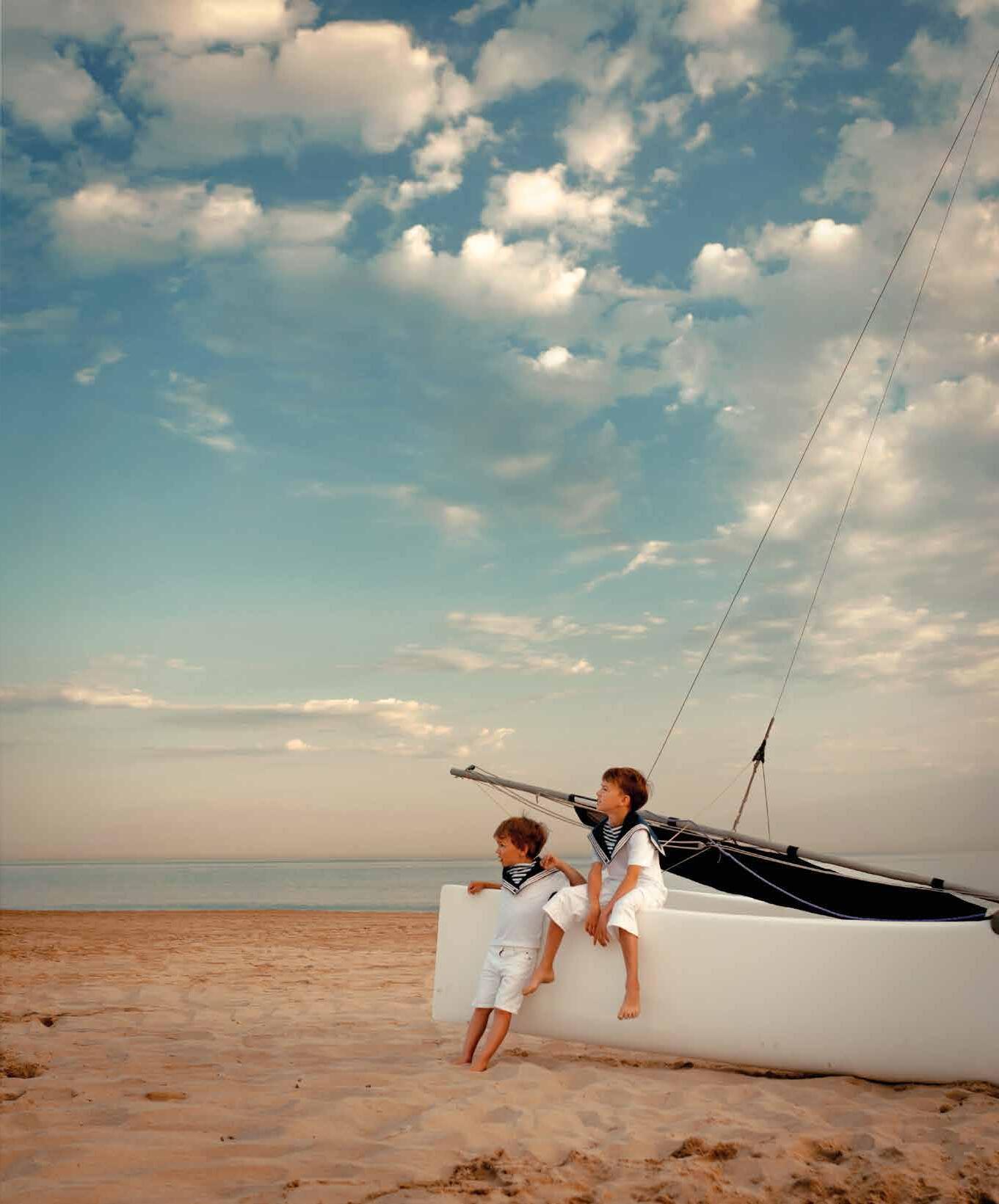
Let’s preserve what inspired our passion
REFIT FOR THE FUTURE!
Discover our solutions to drive sustainability and improve value
